Geneva Motor Show 2016: Koenigsegg Agera Final Edition
[New Car Launch] At the recently opened 2016, the famous manufacturer released the final version of the model. In the future, Agera will be officially replaced as a brand-new sports car product of Koenigsegg.


Agera is a super sports car launched by Koenigsegg in 2010, followed by Agera R, Agera S, Agera HH, Agera RS and models, and the final version of ——Agera One of 1 this time also marks the curtain call of Agera models.



The appearance of the new car refers to the design style of Agera One:1. The overall appearance of the new car is orange-red with carbon fiber, and the number of carbon fiber spoilers on both sides of the front bumper is increased to four, making it look more aggressive.





As for the rear part, we can’t see the specific changes because of the opening of the rear hatch cover, but according to official data, the rear active spoiler can provide 455kg downforce when the new car reaches 260km/h and 650kg downforce when it reaches 440 km/h. In addition, the One of 1 logo on the side fender of the new car is different from the old model.



In terms of interior, the new car is decorated with black leather and orange stitching, and the visual effect is excellent. In addition, the car is also equipped with carbon fiber air outlets and decorative panels, which highlights the sporty atmosphere.

In terms of power, the new car is equipped with a 5.0LV8 engine, with a maximum of 1,360 horsepower and a peak of 1,371 Nm. Compared with ONE:1, it increases 19 horsepower. In terms of transmission, the engine is matched with a 7-speed.
Thanks to the all-carbon fiber construction and design of the new car, the self-weight of the new car is only 1375kg, which is 20kg lighter than Agera RS and even 55kg lighter than ONE:1. According to the official, the 0-100km/h acceleration of the new car takes only 2.8 seconds, reaching 440km/h rapidly. (Text/car home Bao Jinchen; Figure/Team in front of car home)
Read more:
Two new cars Koenigsegg announced the lineup of Geneva Motor Show.
//www.autohome.com.cn/news/201602/884819.html
Buying and selling a "death certificate" can be done for more than 100 yuan? What is this "ghost business"
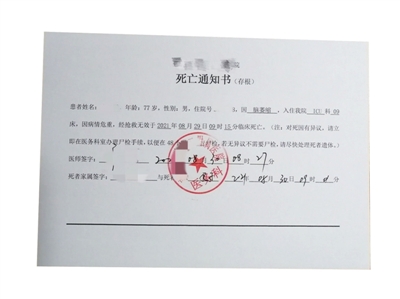
False death certificate
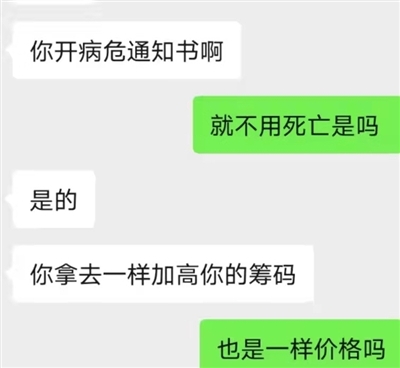
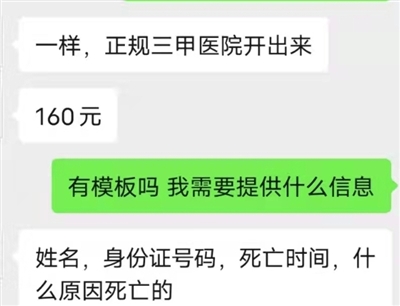
Screenshot of reporters chatting with merchants
Nowadays, handling business on behalf of the public is quite popular. Have you ever heard that a "death certificate" can also handle it? Recently, a reporter’s investigation found that you can get a death certificate without spending 200 yuan on the online platform. A merchant "intimate" said that if you need to go to court to increase your chips, you can also open a "notice of critical illness", which is more effective than a "death certificate". It is worth mentioning that during the investigation, the reporter noticed that the "death certificate" templates created by merchants are varied, and some even have incomplete basic identity information. Relevant legal persons reminded that if a merchant knows that the buyer regards it as perjury and sells it maliciously, it is suspected of violating the law.
shock
You can open a "death certificate" without going to 200 yuan.
Merchant: There are formal channels in the hospital.
On the morning of November 22nd, the reporter searched for the word "critically ill" on Taobao platform, and some agency businesses popped up, with the key words marked as providing sick leave and other services. When private messages are asked, merchants will often ask consultants to add their WeChat. The reporter tweeted and added WeChat of three merchants.
The first merchant said that he could issue a death certificate, the price of which was 130 yuan, and he only needed to tell his name, ID number, address and time of death. Another businessman said that he can issue death certificates from hospitals all over the country. "160 yuan from a regular top three hospital needs his name, ID number, time of death and why he died." The merchant said that he has formal channels in the hospital. The third merchant said that his death certificate was sold in 150 yuan, which was also true.
The reporter noticed that the templates of death certificates provided by the three merchants are different. Some only indicate the patient’s name, age, hospitalization number, cause of death and time of death, while others are very comprehensive, including identity number, actual age, specific place of death (hospital ward, emergency room, on the way to the hospital), the cause of death, and the highest diagnostic basis of the disease.
More shocked
You can also open a notice of critical illness
Merchants: You can increase your "chips" when defending your rights.
During the conversation, a merchant said that his own death certificate can be used to open a hospital or a police station, and the price of the death certificate of the police station is relatively high. Immediately, he said that it is necessary to know the purpose of the death certificate. If the death certificate is used for criminal disputes through legal channels, it will not be issued. "That risk is too great, and you are also dangerous. The death certificate of the hospital can be opened here." "
Later, the merchant said that if a person has not died and needs to go to court or defend his rights, he can issue a corresponding notice of critical illness to the hospital. "If you take it, you will raise your chips. If you really die, you will not pay so much, and the notice of critical illness will pay more." In response to the question raised by the reporter of the New Yellow River whether it is reliable and whether the hospital will verify it, the other party said that "people lying in bed are also critically ill. If you die, it is unrealistic. After all, people are not really dead. The critically ill notice is already very serious, and it will definitely increase the chips. I can also open an injury appraisal here, and I can give you a serious one. "
The reporter found in the China Judgment Document Network that some civil disputes really revolved around the falsification of injury identification, and some litigants complained that the injured did not touch some parts, but their injury identification documents showed different results.
Distinguish truth from falsehood
Medical practitioners: part of the proof is "fake at a glance"
Is the "fake death" certificate provided by the above-mentioned merchants reliable? The reporter consulted two staff members of the top three hospitals. The other party said that some death certificates did not even indicate the information such as the ID number of the deceased, which was a "one-look leave".
Speak the law
Lawyer:
Handling false death certificates
It is a crime
Search found that in recent years, there are not a few oolong mistakes caused by forging death certificates. In 2020, a man in Jiangsu was released on bail for defrauding 1.9 million yuan, in an attempt to evade the trial by giving himself a fake death certificate, cremation certificate and account cancellation certificate. In the end, the man was added to the crime of forging official documents and seals of state organs.
"Formal judicial authentication documents often come from judicial authentication centers and need to check their qualifications. Casual injury identification, death certificate, etc., if used for dispute handling, the court also needs to examine its authenticity. " Lawyer Yuan Qian of Shandong Zhengtang Law Firm said that such acts as men obtaining false death certificates to get rid of crimes are very bad in nature and have been criminal acts.
The reporter learned that according to the Criminal Law of People’s Republic of China (PRC), forging, altering, buying or selling or stealing, robbing or destroying official documents, certificates and seals of state organs are sentenced to fixed-term imprisonment of not more than three years, criminal detention, public surveillance or deprivation of political rights; If the circumstances are serious, he shall be sentenced to fixed-term imprisonment of not less than 3 years but not more than 10 years. Whoever forges the seal of a company, enterprise, institution or people’s organization shall be sentenced to fixed-term imprisonment of not more than three years, criminal detention, public surveillance or deprivation of political rights.
According to the new yellow river client
Spend 130 yuan to "fake death"
How can the platform be really blind?
Journalists can find these fake shops through keyword search and other methods. If the platform with more information and data is really managed, it is impossible to manage it.
Critical notice and death certificate are extremely serious medical documents, which are related to people’s life and death. However, such documents are actually sold on the Internet at will, and you only need to spend more than 100 yuan to provide your ID number, address and time of death, and you can choose the death certificates of hospitals all over the country. From the convenience of purchase and the low cost of counterfeiting, we can see how mature the "grey production chain" behind the proof has reached.
The fraud of critical notice and death certificate is obvious. In 2020, a man in Jiangsu was released on bail for defrauding 1.9 million yuan, in an attempt to evade the trial by giving himself a fake death certificate, cremation certificate and account cancellation certificate. In addition, news such as helping yourself to defend your rights by issuing a certificate, which is used to defraud insurance, also appears from time to time. It is conceivable that false proof of "grey property" not only undermines social integrity, but also inevitably encourages a large number of illegal and criminal acts, bringing unpredictable risks to society.
Similar to proving counterfeiting, both buyers and sellers have violated the law. Merchants who forge such certificates for a certain amount or times, or cause serious harmful consequences, will be suspected of forging, altering, buying and selling official documents, certificates and seals of state organs. The Law on Public Security Administration Punishment also has corresponding penalties for "buying, selling or using forged or altered official documents, certificates and supporting documents of state organs, people’s organizations, enterprises, institutions or other organizations". However, why is the underground chain behind this still rampant?
Among them, the indulgence of related platforms is probably a key factor. In fact, it is nothing new to falsify critically ill notices and death certificates. Over the years, there have been constant media reports. However, often, as soon as there is media intervention, the relevant platforms will pay attention to it. For example, last year, a man in Jiangsu bought a fake death certificate and tried to escape the trial, and the relevant online stores were cleaned up. It can wait until the news is over, and the daily management of the platform becomes lax, which proves that "gray production" will make a comeback.
Admittedly, the transaction of forged certificates has certain concealment. For example, according to the investigation of reporters, some shops are drained through the online platform, and then negotiate and trade through WeChat, which will indeed bring certain difficulties to the supervision of the platform. However, if you make full use of big data, it is not difficult to identify these illegal shops. Journalists can find these fake shops through keyword search and other methods. If the platform with more information and data is really managed, it is impossible to manage it.
Of course, for the supervision of similar forged certification transactions, we can’t just hope for the platform’s consciousness. As the relevant regulatory authorities, they also have the responsibility to supervise and compact the main responsibility of each platform. For the network platform that indulges and proves "gray production", it is not just self-examination and correction, but should be punished according to law. In this way, we can force the platform to "keep the soil responsible" and try our best to cut off the trading chain that proves "gray production".
Chengdu Business Daily-Special Commentator of Red Star News Yu Ping
Announcement of Listed Companies in Shenzhen (September 2)
Baiao Intelligent: Baiao Software, a subsidiary, received a software tax refund totaling 2,962,700 yuan.
Released on September 1st-() It was announced that Kunshan Baiao Software Co., Ltd., a wholly-owned subsidiary of the company, received a total software tax refund of 2,962,700 yuan on August 31st, accounting for 29.20% of the absolute value of the company’s latest audited net profit attributable to shareholders of the parent company, which will be included in the company’s other income and recognized as current profits and losses.
Liancheng Precision: By the end of August, 0.9915% of the shares had been repurchased, and the total amount paid was about 18.74 million yuan.
According to the announcement released on September 1st-(), as of August 31st, 2022, the company has repurchased about 1,305,600 shares by centralized bidding through the special securities repurchase account, accounting for 0.9915% of the company’s total share capital, with the highest transaction price of 14.99 yuan/share and the lowest transaction price of 13.84 yuan/share, and the total amount paid is about 18.74 million yuan.
Mona Lisa: Seven invention patent certificates have been obtained and have been applied in product production.
Released on September 1st-() It was announced that the company had recently obtained seven invention patent certificates issued by China National Intellectual Property Administration, including a humidity-regulating ceramic tile with decorative effect and its preparation method, a glazed tile with full glazing and its preparation method, a ceramic plate with high solar reflectivity and its preparation method, a sodium-bentonite foamed ceramic blank, a sodium-bentonite foamed ceramic tile and its preparation method, etc.
Zhongke Electric: With the participation of Yingfeng Capital, a well-known institution, a total of 25 institutions investigated our company on August 30th.
On August 30th, 2022 (), it was announced that CITIC Asset Management Xu Hongtu Cheng Jiteng Luo Siwei Xiao Yayu Li Pinke, CICC Capital Xie Qi, Bosera Fund Geng Guiyan, Pengyang Fund Deng Binbin, People’s Insurance Fund Sun Haoran, Taiping Pension Meng Xingya, Ping An Fund Zhang Xiaoquan, Yuanxin Private Equity Zhao Weihua Zhou Weifeng Huang Yirui Liu Guangxu, Caitong Asset Management Shao Shakun, Guohua. Yingfeng Capital Asia Li Minggang Zhang Tingjian Dong Liu gradually, Jiangsu Ruihua Zeng Biao, Hao Capital Zhao Xin, Shagang Investment Li Shengnan Zhang Shuyi, other 92 institutions, Dacheng Fund Yuan Qinglong, Three Gorges Capital Wang Song Wu Bofan, Hongtu Innovation Luan Xiaoming, Qianhai Kaiyuan Xu Guangjin, harvest fund Ye Liu Liu Jie, southern fund Ren Jing and Huaxia Fund Li Xiangjie investigated our company on August 30, 2022.
The details are as follows:
Q: What is the current production schedule and capacity building of the company’s anode materials?
A: At present, the company’s production capacity is tight, and the supply of products is in short supply. In this regard, the company’s related new capacity construction projects are being actively promoted as planned. After all the construction is completed, the company’s anode material production capacity will be 440,000-450,000 tons/year, the anode material graphitization processing capacity will be 395,000 tons/year (including the shareholding subsidiary Jineng’s new material graphitization processing capacity of 30,000 tons/year), and the graphitization self-sufficiency rate will be nearly 90%.
Q: What are the main components and price changes of raw materials for the company’s anode materials business? What is the price of the company’s negative electrode materials?
A: The raw materials of the company’s anode materials are mainly coke raw materials such as petroleum coke and oil-based needle coke. Since the beginning of this year, the purchase prices of needle coke and petroleum coke have increased to a certain extent, and the company’s cost pressure has increased. In this regard, the company actively cooperates with the upstream and downstream to jointly maintain the sustained and healthy development of the industrial chain on the principle of mutual assistance and common overcoming.
Q: How can the company ensure the supply of raw materials in the future?
A: The company has maintained a long-term and stable cooperative supply relationship with upstream needle coke and petroleum coke manufacturers. At the same time, the company has carried out cooperative layout in the petroleum coke field to further ensure the supply of raw materials. For example, the company increased its capital in Anhui Haida New Materials Co., Ltd. and participated in the construction of the "production base project with an annual output of 100,000 tons of anode material powder" to make it a raw material supply and production and processing base for the company’s anode materials.
Q: Please tell us about the company’s fast-charging anode products.
A: The company’s fast-charging anode products mainly include fast-charging products with high cost performance and high energy density. These products have been successfully applied in batches at the client, and they have been well received by the market in terms of product performance and cost performance.
Q: Please tell us about the development of new negative electrodes such as sodium ion battery negative electrode and silicon-based negative electrode.
A: The company has continuously developed hard carbon materials for sodium ion batteries, among which the production of hard carbon materials can be shared with part of the production capacity of existing graphite anode materials. As for the silicon-based anode, the company has continuously invested, and the pilot production line has been completed. In addition, the company has always insisted on doing relevant forward-looking research in the field of new energy materials, and reserving the technology and talents of related materials for the future development direction of new energy batteries.
Q: What is the impact of power shortage in Sichuan on the company’s production?
A: It has had a certain impact on the company’s supply chain, but at present, the impact is controllable and the company has taken corresponding measures to deal with it.
Q: Please tell us about the application of the company’s anode materials in the field of energy storage.
A: The application field of energy storage is also an important direction for the company’s lithium battery anode business development. At present, the company’s anode products have been supplied to energy storage projects in batches.
Q: What do you think of the future development of graphitization process?
A: At present, whether it is Acheson graphitization furnace, box graphitization furnace or continuous graphitization furnace, their technologies are still improving and their processes are still being optimized. There is room for different types of graphitization furnaces to reduce costs and improve quality.
Q: What is the significance of asking the company to transfer its equity to Hunan Zhongke Xingcheng Technology Co., Ltd., a wholly-owned subsidiary?
A: The company’s equity transfer is the company’s optimization and adjustment of the equity structure of existing subordinate enterprises, which is conducive to improving management efficiency, rationalizing the management structure of the New Energy Materials Division, integrating internal resources, and making the lithium battery negative business sector bigger and stronger. This equity transfer is a transfer between enterprises within the scope of the company’s consolidated statements, and does not involve changes in the scope of the consolidated statements.
Q: What are the reasons for the sharp drop in the net cash flow generated by the company’s operating activities in the first half of 2022?
A: The year-on-year decrease in net cash flow from operating activities in the first half of 2022 was mainly due to the substantial increase in the company’s business scale. On the one hand, in order to meet production needs, the company expanded its expenditure on purchasing raw materials and the scale of stocking. At the same time, the market graphitized external processing’s production capacity was tight, and the prepayments for graphitized external processing’s production capacity to lock in the market increased, which led to more cash growth and increased inventory. On the other hand, the downstream sales increased significantly, and the payment was mainly in bills, which led to a large increase in the amount of operating receivables.
Q: What is the room for cost reduction in the negative electrode material business of the company?
A: Raw material procurement and graphitization account for a large proportion in the production cost of artificial graphite anode materials. Among them, the raw materials are mainly coke raw materials such as petroleum coke and needle coke. The company enhances its cost advantage by improving its raw material development ability and seeking alternatives for high cost-effective raw materials. Graphitization is a key link in the production of artificial graphite anode materials, and it also accounts for a relatively large production cost. In this regard, compared with the traditional graphitization production line, the new Acheson graphitization furnace designed and built by the company has the advantages of low power consumption cost, low cost of furnace core consumables and high degree of automation, and has a leading advantage and cost advantage in graphitization processing technology of negative electrode materials in China; At the same time, the company reduces the construction cost of graphitization production line and improves the utilization rate of graphitization production line through measures such as technology and process optimization and upgrading; In addition, the company improves the graphitization self-sufficiency rate through the construction of anode material integration project, so as to reduce the graphitization processing cost and enhance the competitive advantage.
Zhongke Electric’s main business: mainly engaged in research and development, production, sales and service of industrial magnetic application technology and products.
Zhongke Electric’s 2022 interim report shows that the company’s main income is 2.033 billion yuan, up 147.07% year-on-year; The net profit of returning to the mother was 263 million yuan, up 64.91% year-on-year; Deducting non-net profit was 284 million yuan, up 81.17% year-on-year; In the second quarter of 2022, the company’s main revenue in a single quarter was 1.175 billion yuan, up 137.44% year-on-year; The net profit returned to the mother in a single quarter was 134 million yuan, up 45.62% year-on-year; The non-net profit in a single quarter was 143 million yuan, up 55.79% year-on-year; The debt ratio is 51.34%, the investment income is 22.3907 million yuan, the financial expenses are 71.0507 million yuan, and the gross profit margin is 23.4%.
In the last 90 days, the stock has been rated by 16 institutions, with 15 buy ratings and 1 overweight rating. The average target price of institutions in the past 90 days was 36.98.
The following is the detailed profit forecast information:

According to the financial report data in the past five years, the Securities Star valuation analysis tool shows that Zhongke Electric has a good moat of competitiveness, average profitability and good revenue growth. There may be hidden troubles in finance, and the financial indicators that should be focused on include: interest-bearing asset-liability ratio, accounts receivable/profit rate. The stock has a good company index of 2 stars, a good price index of 2.5 stars and a comprehensive index of 2 stars. (The index is for reference only, and the index range is 0~5 stars, with a maximum of 5 stars)
Zhongxin Tourism has reduced its holdings of 9 million repurchased shares.
() Announcement was issued. As of August 31st, 2022, the company has reduced the number of repurchased shares by centralized bidding to 9 million shares, accounting for 0.9929% of the company’s total share capital. The total amount of funds obtained from the reduction is 58,932,200 yuan (without deducting transaction costs), with the highest price of 7.03 yuan/share, the lowest price of 6.38 yuan/share and the average price of reduction of 6.55 yuan.
Weining Health has spent 121 million yuan to buy back 14.2564 million shares.
() Announcement was issued. As of August 31st, 2022, the company repurchased 14,256,400 shares of the company through the special securities account for share repurchase, accounting for 0.66% of the company’s current total share capital. The highest transaction price was 9.744 yuan/share, the lowest transaction price was 722 yuan/share, and the total transaction amount was 121 million yuan.
Colorful Chemical has repurchased 6.923 million shares at a cost of 78.99 million yuan.
() Announcement was issued. As of August 31st, the company repurchased 6.923 million shares through the special securities account for stock repurchase, accounting for 1.69% of the company’s total share capital. The highest transaction price was 12.94 yuan/share, the lowest transaction price was 8.74 yuan/share, and the total payment was 78.99 million yuan.
China International Consortium signed the PPP project contract for Dalian kitchen waste treatment plant project.
() announced that on August 31, 2022, the consortium formed by the company and Changzhou () and Dalian Municipal Public Utilities Service Center signed the PPP project contract for the kitchen waste treatment plant project in downtown Dalian.
The total investment of the PPP project of the kitchen waste treatment plant project in downtown Dalian is 535 million yuan, of which the project capital is 134 million yuan. This project is to build a new kitchen waste treatment plant with the processing capacity of 300 tons/day of kitchen waste and 300 tons/day of household kitchen waste, build a kitchen waste pretreatment workshop, and support anaerobic fermentation and its supporting system, sewage treatment and deodorization system, etc.
The project company will be jointly funded by CCT and Changzhou Welley, and the project company will be responsible for the investment, financing, construction, operation, maintenance and handover of the project facilities, and obtain the garbage disposal service fee and related income. The cooperation period of this project is 27 years, including 2 years of construction and 25 years of operation.
Hua Kai Yibai: Yibai Network has completed the rectification of the third-party nominal online store.
() Announcement: As of August 31, 2022, Yibai Network completed the rectification of 456 third-party nominal online stores through the change of the main equity of online stores to Yibai Network or its subsidiaries, actively closed 49 third-party nominal online stores and transferred them to 30 third-party nominal online stores of independent third parties. Ebay Network has completed the rectification of the third-party online store, and there is no case of opening a store in the name of a third party.
Zhejiang Mining Co., Ltd. received an inquiry letter from Shenzhen Stock Exchange about the company’s issuance of convertible bonds.
() Announcement was issued. On September 1st, the company received the "Letter of Inquiry about Zhejiang Mining Heavy Industry Co., Ltd. applying for issuing convertible corporate bonds to unspecified objects" issued by Shenzhen Stock Exchange. The listing audit center of Shenzhen Stock Exchange has audited the application documents submitted by the company to issue convertible corporate bonds to unspecified objects, and has formed an audit inquiry problem.
CCT International: Signed the PPP project contract for the kitchen waste treatment plant project in downtown Dalian.
On the evening of September 1st, China National Engineering Corporation announced that on August 31st, the consortium formed by the company and Changzhou Wiley signed a PPP project contract with Dalian Municipal Public Utilities Service Center. The total investment of this project is 535 million yuan. The company will jointly establish a project company with Changzhou Welley, and the project company will be responsible for the investment, financing, construction, operation, maintenance and handover of the project facilities, and obtain the garbage disposal service fee and related income. The cooperation period of the project is 27 years, including 2 years of construction and 25 years of operation.
Xinhe shares have bought back 2.12% of the shares, with a total cost of 80.2492 million yuan.
() Announcement was issued. As of August 31st, 2022, the company repurchased 9.15 million shares of the company through the special account for share repurchase securities, accounting for 2.12% of the company’s current total share capital. The highest transaction price was 9.69 yuan/share, the lowest transaction price was 7.86 yuan/share, and the total transaction amount was 80.2492 million yuan.
Weifu Hi-Tech bought back 13.3025 million shares at a cost of 256 million yuan.
() Announcement was issued. As of August 31st, 2022, the company repurchased 13,302,500 shares (A shares) by centralized bidding through the special securities account, accounting for 1.32% of the company’s current total share capital, of which the highest transaction price was 20.85 yuan/share and the lowest transaction price was 18.00 yuan/share, and the total amount paid was 256 million yuan (including transaction fees).
Haichen Pharmaceutical received an inquiry letter from Shenzhen Stock Exchange for issuing shares to a specific target.
() Announcement. On September 1st, the company received the "Letter of Inquiry on the Application of Nanjing Haichen Pharmaceutical Co., Ltd. to Issue Shares to Specific Objects" issued by the Listing Audit Center of Shenzhen Stock Exchange. The audit institution of Shenzhen Stock Exchange has audited the application documents submitted by the company to issue shares to specific targets, and has formed an audit inquiry problem.
Rong Sheng Petrochemical has spent 536 million yuan to buy back 36.5978 million shares.
() Announcement was issued. As of August 31st, 2022, the company repurchased 36,597,800 shares of the company by centralized bidding through the special securities account, accounting for 0.3614% of the company’s total share capital. The highest transaction price was 1.545 yuan/share, the lowest transaction price was 1.399 yuan/share, and the total transaction amount was 536 million yuan.
Zhizhen Technology repurchased 1.18% of the shares at a cost of 22.88 million yuan.
() Announcement was issued. As of August 31st, 2022, the company repurchased 1,223,500 shares of the company by centralized bidding through the special securities account, accounting for 1.1764% of the company’s current total share capital. The highest transaction price was 18.98 yuan/share, the lowest transaction price was 16.90 yuan/share, and the transaction amount was 22.88 million yuan (excluding transaction costs).
Qiao Junfeng, deputy general manager of Shanxi Securities, resigned and two general assistants were promoted to deputy general managers.
(Wang Yanlin, reporter Wang Youruo) On September 1, Shanxi Securities announced the change of executives. According to the announcement, it is agreed to appoint Han Liping and Liu Runzhao as the deputy general managers of the company, and the term of office will be from the date of deliberation and approval by the board of directors to the expiration of the fourth board of directors. Qiao Junfeng applied to resign as the deputy general manager of the company for work reasons.
It is reported that Qiao Junfeng will continue to serve as the employee director and member of the Executive Committee of the company after resigning as the deputy general manager of the company, and continue to serve as the chairman of the subsidiary Shanzheng International Financial Holdings Co., Ltd. and the chairman and general manager of Shanzheng (Shanghai) Asset Management Co., Ltd.
According to public information, Han Liping was born in 1974 with a postgraduate degree. She joined Shanxi Securities in July 2002, and has been the assistant to the general manager of Shanxi Securities since March 2017. Member of Shanxi Securities Executive Committee since December 2020; Since December 2021, he has served as the general manager of Shanxi Securities Financial Products Department (concurrently); Since June 2022, he has served as a member of the Party Committee of Shanxi Securities.
Liu Runzhao was born in 1974 with a bachelor’s degree. He joined Shanxi Securities in August 2000, and worked in the securities business department, investment banking department and general management department of Wuyi Road of Shanxi Securities successively. Since February 2017, he has served as assistant to the general manager of Shanxi Securities; Member of Shanxi Securities Executive Committee since December 2020; October 2021 to present, Executive Director of Ren Shan Securities Investment Co., Ltd.; Since November 2021, General Manager of Ren Shan Securities Investment Co., Ltd.; Executive Director of Ren Shan Securities Innovation Investment Co., Ltd. since August 2021; Since June 2022, he has served as a member of the Party Committee of Shanxi Securities.
The credit standard granted 494,360 restricted shares at a price of 14.49 yuan/share.
() Announcement, the reserved grant conditions stipulated in the Company’s Restricted Stock Incentive Plan 2021 (Draft) have been achieved, and the company has decided to take August 31, 2022 as the reserved grant date, and grant 494,360 reserved restricted shares to 55 incentive objects meeting the grant conditions at the price of 14.49 yuan/share.
The cumulative repurchase ratio of Jiajia food reached 1.32%, costing 71 million yuan.
() Announcement: As of August 31, 2022, the company has bought back 15,168,200 shares by centralized bidding, accounting for 1.32% of the company’s total share capital. The highest transaction price is 6.29 yuan/share, the lowest price is 4.05 yuan/share, and the total transaction amount is 71,000,900 yuan (including transaction costs).
Guanglian Airlines: It is planned to invest 300 million yuan to build the UAV assembly and spare parts manufacturing project.
() On the evening of September 1st, it was announced that the company intends to sign the Agreement on the Construction of UAV Assembly and Spare Parts Manufacturing Project with the Gongjing District People’s Government of Zigong City. The company plans to use the project construction area of about 57,500 square meters to build the UAV assembly plant and ancillary buildings, and build a new UAV assembly and spare parts production line with a total investment of 300 million yuan.
Dashi Intelligent Consortium signed 227 million yuan smart transportation project.
() Announcement. Recently, the company, as the leader and member of the consortium, China Railway Wuhan Electrification Bureau Group Co., Ltd. and China Railway Urban Development Investment Group Co., Ltd. (hereinafter referred to as "China Railway Group") reached a consensus on matters related to the integration and installation of the integrated monitoring (including communication) system of Chengdu metro line 8 Phase II project, and formally signed a project contract in Chengdu, with a contract amount of about 27 million yuan.
Jilin Aodong has repurchased 6,478,300 shares at a cost of 92,581,900 yuan.
() Announcement was issued. As of August 31st, the company repurchased A shares of the company through the special securities account for stock repurchase, and the number of repurchased shares was 6,478,300 shares, accounting for 0.56% of the total share capital of date of record on August 31st. The highest transaction price of the purchased shares is 14.80 yuan/share, the lowest transaction price is 13.80 yuan/share, and the total payment is 92.5819 million yuan.
Dongpeng Holdings won the 7th Guangdong Provincial Government Quality Award.
() Announcement was issued. On September 1, 2022, the company received the Notice of Guangdong Provincial People’s Government on Commending the Winners of the Seventh Guangdong Provincial Government Quality Award (Guangdong Government Letter [2022] No.229), and the Guangdong Provincial People’s Government decided to award Guangdong Dongpeng Holdings Co., Ltd. the Seventh Guangdong Provincial Government Quality Award.
Dongpeng Holdings repurchased 13.4747 million shares at a cost of 130 million yuan.
Dongpeng Holdings announced that as of August 31, 2022, the company had bought back 13,474,700 shares of the company by centralized bidding through the special securities account, accounting for 1.14% of the company’s current total share capital, of which the highest transaction price was 1.184 yuan/share, the lowest transaction price was 7.81 yuan/share, and the total transaction amount was 130 million yuan (excluding transaction fees).
China Resources Trust, the major shareholder of Zhongnan Culture, plans to reduce its holdings by no more than 2.6291%.
() Announcement: China Resources SZITIC Trust Co., Ltd.-China Resources Trust Zhaoli No.21 Single Fund Trust (hereinafter referred to as "China Resources Trust"), which holds more than 5% of the company’s shares, intends to reduce its holdings of the company’s shares by centralized bidding and/or block trading, with a total reduction of no more than 62.88 million shares (accounting for about 2.6291% of the company’s total share capital).
Chengde Lulu has bought back 1.55% of the shares and spent about 141 million yuan.
() Announcement was issued. As of August 31, 2022, the company repurchased 16,715,500 shares of the company by means of centralized bidding, accounting for 1.55% of the total share capital, and paid a total amount of 141 million yuan.
Zhongnan Culture: Shareholder China Resources Trust intends to reduce its shareholding by no more than 2.63%.
On the evening of September 1st, Zhongnan Culture announced that China Resources SZITIC Trust Co., Ltd.-China Resources Trust. Zhaoli No.21 Single Fund Trust, which holds 7.9002% of the shares, intends to reduce its holding of the company’s shares by centralized bidding and/or block trading to no more than 62.88 million shares (accounting for 2.6291% of the company’s total share capital).
Dashi Intelligent: Signed a contract for intelligent transportation projects of about 227 million yuan.
Dashi Intelligent announced on the evening of September 1st that recently, as the leader of the consortium and a member of the consortium, China Railway Wuhan Electrification Bureau Group Co., Ltd. and China Railway Group reached a consensus on the integration and installation of the integrated monitoring (including communication) system of Chengdu metro line 8 Phase II project, and formally signed a project contract in Chengdu, with a contract amount of about 227 million yuan, accounting for 7.16% of the company’s audited operating income in 2021.
Hokuriku Pharmaceutical set up a wholly-owned R&D subsidiary to create the second growth curve.
() Announced that in order to further improve the company’s R&D system, enhance its R&D strength, create a second growth curve, and realize the development goal of becoming a "Top 100 Pharmaceutical Enterprises in China", the company established a wholly-owned subsidiary Beijing Beilu Yikang Pharmaceutical R&D Co., Ltd. with its own capital of 10 million yuan. Recently, Beijing Beiliu Yikang Pharmaceutical R&D Co., Ltd. completed the industrial and commercial registration registration and obtained the Business License issued by Changping District Market Supervision Administration of Beijing.
The company has decided to select cardiovascular and cerebrovascular systems, digestive systems and nervous (mental) systems (chemical drugs) with large market demand as the key project areas in order to solve the clinical needs, in addition to the contrast agent field, central nervous system field (Chinese patent medicine) and endocrine field. The company set up a wholly-owned subsidiary, Beilu Yikang, and established a brand-new R&D system with R&D center and enterprise development department (BD). Three relatively independent and collaborative R&D institutions will greatly enhance the company’s R&D strength.
Yutong Technology’s cumulative repurchase ratio reached 1.0609%, costing 259 million yuan.
() Announcement: By August 31, 2022, the company had repurchased 9,871,600 shares, accounting for 1.0609% of the company’s total share capital. The highest transaction price was 34.40 yuan/share, the lowest transaction price was 23.57 yuan/share, and the total transaction amount was 259 million yuan (excluding transaction costs).
Jinhe Bio bought back 1.28% of the shares at a cost of 45,982,400 yuan.
() Announcement was issued. As of August 31st, 2022, the company has repurchased 10.01 million shares of the company by centralized bidding through the special securities account, accounting for 1.28% of the company’s total share capital. The highest transaction price was 4.78 yuan/share, and the lowest transaction price was 4.39 yuan/share, with a total turnover of 45.9824 million yuan (excluding transaction costs).
(): The high-tech land belonging to high-tech electric porcelain is included in the annual plan of urban renewal project of Shenfu Demonstration Zone in 2022.
Chuangyuan Science and Technology announced that Fushun Gaoke Electric Porcelain Electric Manufacturing Co., Ltd. (hereinafter referred to as "Gaoke Electric Porcelain"), a holding subsidiary of the company, received the Notice on the inclusion of the land belonging to Gaoke Electric in the urban renewal project of Shenfu Demonstration Zone issued by the Management Committee of Shenfu Reform and Innovation Demonstration Zone in Liaoning Province. The high-tech land belonging to the company’s holding subsidiary, High-tech Electric Porcelain, has been included in the annual plan of the urban renewal project of Shenfu Demonstration Zone in 2022.
The cumulative repurchase ratio of Dinglong shares reached 1.25%, costing 200 million yuan.
() Announcement: As of August 31, 2022, the company has repurchased 11,820,200 shares, accounting for 1.25% of the company’s total share capital as of August 31, 2022. The highest transaction price is 18.29 yuan/share, and the lowest transaction price is 15.07 yuan/share, and the total amount paid is 200 million yuan (excluding transaction costs).
Zhongnan Culture: China Resources Trust intends to reduce its shareholding by no more than 2.63%.
On September 1 ST, Zhongnan Culture announced that the number of shares to be reduced by shareholders should not exceed 62.88 million shares, that is, it should not exceed 2.6291% of the company’s total share capital.
Kang Hua Bio bought back 0.61% of the shares at a cost of 116 million yuan.
() Announcement was issued. As of August 31st, 2022, the company repurchased 825,000 shares of the company through the stock repurchase special securities account, accounting for 0.61% of the company’s total share capital. The highest transaction price was 21.100 yuan/share, the lowest transaction price was 8.895 yuan/share, and the total transaction amount was 116 million yuan (excluding transaction fees).
*ST Xifa: Lhasa Beer, a subsidiary, continued to stop production.
() On the evening of September 1st, it was announced that in order to actively respond to and implement the relevant announcement requirements of the Office of the Leading Group for COVID-19 Epidemic Response in Lhasa, the subsidiary Lhasa Beer continued to stop production, and the factory arranged the person in charge and the personnel on duty to cooperate with the community work. Most employees worked at home, and the time to resume normal production and operation would be arranged according to the local government’s epidemic control requirements.
Luo Hong, the major shareholder of Wufang Optoelectronics, completed the reduction of 2.2% shares.
() Announcement. Recently, the company received the Letter of Notice on the Completion of the Implementation of the Share Reduction Plan issued by Mr. Luo Hong, a shareholder who holds more than 5% of the shares. As of the disclosure date of this announcement, Mr. Luo Hong’s share reduction plan has been implemented, with a total reduction of 6.464 million shares and a reduction ratio of 2.2%.
Zhenxin Technology received government subsidy of 56.62 million yuan.
() Announcement was issued. On August 31st, the company received the second phase of the special subsidy fund for industrialization from the Development and Reform Bureau of Chengdu Hi-tech Industrial Development Zone, amounting to 56.62 million yuan. This special subsidy shows that the company has strong independent innovation and industrial application ability in the research and development of key devices, which will promote the company’s industrial development and enhance its core competitiveness.
Yingqu Technology has bought back 0.87% of the shares and spent 148 million yuan.
() Announcement was issued. As of August 31st, 2022, the company repurchased 6,804,700 shares of the company through the special securities account for share repurchase, accounting for 0.8692% of the company’s current total share capital. The highest transaction price was 25.97 yuan/share, the lowest transaction price was 1,826 yuan/share, and the total transaction amount was 148 million yuan (excluding transaction costs).
The controlling shareholder of Swan Co., Ltd. pledged 6.461 million shares and 6.54 million shares of supply and marketing capital.
() Announcement was issued. On September 1, 2022, the company received the Letter of Notification from the controlling shareholder’s supply and marketing capital. The 6,461,000 shares pledged by the supply and marketing capital to Shanxi Securities Co., Ltd. (hereinafter referred to as "Shanxi Securities") expired on August 31, 2022, and the 6,540,000 shares held by the company were pledged to Shanxi Securities on September 1, 2022.
Chen Xiujuan, an executive of Deyi Wenchuang, plans to reduce his holdings by no more than 295,000 shares.
() Announcement, Chen Xiujuan, a senior manager of the company, plans to reduce the total number of shares of the company by block trading or centralized bidding, which shall not exceed 295,000 shares and 0.0944% of the total share capital of the company.
Jiashi Technology repurchased 1.56% of the shares at a cost of 73.8309 million yuan.
() Announcement was issued. As of August 31, 2022, the company repurchased 7,588,900 shares of the company through the special securities account for share repurchase, accounting for 1.5574% of the company’s total share capital. The highest transaction price was 12.87 yuan/share, the lowest transaction price was 7.51 yuan/share, and the total amount paid was 73,830,900 yuan (excluding transaction fees).
Oriental Seiko has repurchased 8.04% of the shares at a cost of 551 million yuan.
() Announcement was issued. By the close of August 31, 2022, the company had bought back the above-mentioned shares through centralized bidding, with a total of about 106,652,100 shares, accounting for about 8.04% of the company’s total share capital. The highest transaction price was 6.30 yuan/share, the lowest transaction price was 3.59 yuan/share, and the total amount paid was about 551 million yuan.
Dongshan Precision bought back 3,048,700 shares at a cost of 49,990,900 yuan.
() Announced that by the end of August, 2022, the company had repurchased 3,048,700 shares of the company by centralized bidding through the special securities account, accounting for 0.18% of the company’s current total share capital, with the highest transaction price of 16.77 yuan/share and the lowest transaction price of 15.98 yuan/share, with a total turnover of 49,909,900 yuan.
Hanyu Pharmaceutical Co., Ltd.: octreotide acetate API obtained the approval notice for listing application.
() Announcement. On August 31, 2022, Hanyu Pharmaceutical (Wuhan) Co., Ltd. ("Hanyu Wuhan"), a wholly-owned subsidiary of the company, received the Notice of Approval for the Listing Application of Chemical Raw Materials issued by National Medical Products Administration (acceptance number: CYHS2160150), which was publicized on the official website of National Medical Products Administration Drug Evaluation Center.
It is reported that Octreotide is a synthetic octapeptide derivative of natural somatostatin, and its pharmacological action is similar to that of somatostatin, but its action lasts longer. Octreotide can inhibit growth hormone and thyrotropin, inhibit the secretion of gastric acid, pancreatic enzyme, glucagon and insulin, reduce gastric movement and gallbladder emptying, inhibit the secretion of cholecystokinin and pancreatic secretion, and have a direct protective effect on pancreatic parenchymal cell membrane. Reduce visceral blood flow, reduce portal pressure, reduce excessive secretion of intestine, and increase absorption of water and sodium by intestine. It can be used for emergency treatment of esophageal-gastric variceal bleeding caused by acromegaly and liver cirrhosis, combined with special treatment (such as endoscopic sclerosing agent treatment), and can also prevent postoperative complications of pancreas and relieve symptoms and signs related to gastrointestinal endocrine tumors.
Hengyi Petrochemical’s cumulative repurchase ratio reached 1.74%, costing 624 million yuan.
() Announcement: As of August 31, 2022, the company has repurchased 63,703,800 shares, accounting for 1.74% of the company’s total share capital. The highest transaction price of the purchased shares is 11.87 yuan/share, the lowest transaction price is 7.18 yuan/share, and the total amount of repurchase paid is 624 million yuan (excluding transaction costs).
Hanyu Pharmaceutical: octreotide acetate API was approved for listing.
Hanyu Pharmaceutical announced on the evening of September 1st that on August 31st, Hanyu Wuhan octreotide acetate API, a wholly-owned subsidiary of the company, received the Notice of Approval for Listing Application of Chemical API issued by National Medical Products Administration.
Jinjia shares have bought back 0.51% of the shares, with a total cost of 67.59 million yuan.
() Announcement was issued. As of August 31, 2022, the cumulative number of shares repurchased by the company was 7.53 million shares, accounting for about 0.51% of the company’s current total share capital. The highest transaction price was 9.84 yuan/share, the lowest transaction price was 8.15 yuan/share, and the cumulative transaction amount was 67.59 million yuan.
() The major shareholders, Takeda Kenji, Takeda Zhouji, Fujino Yasunari and Qian Chenglin, all pledged 20.5 million shares.
Tanaka Seiki announced that the shares of the company held by shareholders who hold more than 5% of the company, such as Takeda Kenji, Takeda Zhousi, Fujino Yasunari and Qian Chenglin, were pledged, totaling 20.5 million shares, accounting for 15.73% of the company’s total share capital.
Tianshan Aluminum Co., Ltd. repurchased 16.7397 million shares at a cost of 109 million yuan.
() Announcement was issued. As of August 31st, 2022, the company has repurchased 16,739,700 shares of the company by centralized bidding, accounting for 0.36% of the company’s current total share capital, with the highest transaction price of 6.72 yuan/share and the lowest transaction price of 6.36 yuan/share; The total amount of used repurchase funds is 109 million yuan (excluding transaction costs), accounting for 108.99% of the company’s planned repurchase amount of 100 million yuan, accounting for 54.49% of the company’s planned repurchase amount of 200 million yuan.
Feikai Materials has repurchased 2,447,200 shares at a cost of 54,284,600 yuan.
() Announcement was issued. As of August 31st, the company repurchased 2,447,200 shares of the company by centralized bidding through the special securities account, accounting for 0.4629% of the company’s current total share capital. The highest transaction price was 23.78 yuan/share, the lowest transaction price was 20.78 yuan/share, and the total amount paid was 54,284,600 yuan.
Brilliant science and technology won the bid for Zhengzhou rail transit project of about 500 million yuan.
() Announcement. Recently, the company received the Notice of Winning Bid from Zhengzhou Metro Group Co., Ltd., and determined that the company was the winning bidder for the Integrated Monitoring System Integration Project of Zhengzhou Rail Transit Line 7 Phase I, Line 8 Phase I and Line 12 Phase I, with the winning bid amount of about 500 million yuan, accounting for 67.81% of the company’s audited total operating income in 2021. If the project can be successfully signed and implemented, it will have a positive impact on the company’s operating performance this year and in the future.
Bairun shares have spent 90.325 million yuan to buy back 3.2358 million shares.
() Announcement was issued. As of August 31st, 2022, the company has repurchased 3,235,800 shares of the company by centralized bidding, accounting for 0.3081% of the company’s total share capital. The highest transaction price is 32.25 yuan/share, and the lowest transaction price is 24.23 yuan/share, and the total used funds are 90.325 million yuan.
By the end of August, the repurchase ratio of new open source reached 4.72%, costing 269 million yuan.
() Announcement: As of August 31st, 2022, the cumulative number of shares repurchased by the company was 16,292,500 shares, accounting for 4.72% of the company’s total share capital. The highest transaction price of the repurchased shares was 22.98 yuan/share, the lowest transaction price was 12.15 yuan/share, and the total transaction amount was 269 million yuan (excluding transaction costs).
Wanma Co., Ltd. subsidiary plans to sign a relocation compensation agreement with a total compensation of 62,661,800 yuan.
() Announcement: Zhejiang Wanma Group Special Electronic Cable Co., Ltd. (hereinafter referred to as "Wanmat Cable"), a subsidiary of the company, plans to sign the Compensation Agreement for House Relocation on State-owned Land with Qingshanhu Sub-district Office of Lin ‘an District People’s Government of Hangzhou (trustee: Lin ‘an Taishun Relocation Service Co., Ltd.). The total building area involved in this expropriation is 16,991.39 square meters, the total land use right area is 19,156.71 square meters, and the total compensation amount is 62,661,800 yuan.
According to the announcement, this collection will help the company to revitalize its assets, improve the efficiency of the company’s asset operation and increase cash flow. This matter will have a positive impact on the company’s performance.
Honglu Steel Structure Subsidiary won the plot No.2022-013 Gy in Tuanfeng County for 75.14 million yuan.
() Announcement: Recently, Hubei Shenghong Building Materials Co., Ltd., a wholly-owned subsidiary of the company, obtained the right to use the state-owned construction land of plot 2022-013GY in Tuanfeng County, which was sold by the Natural Resources and Planning Bureau of Tuanfeng County through bidding. The transferred parcel area is 475,593.88 ㎡ (the specific area is subject to the actual measurement), and the transaction price is 75,143,833 yuan.
The land won this time is an important part of the investment agreement signed by the company and the Tuanfeng County People’s Government for the Honglu Steel Structure Green Intelligent Assembly Base Project. The acquisition of this land will help to quickly start the construction and operation of the project and increase the company’s production capacity and operating income.
Many directors of Kerui International intend to reduce their holdings by about 810,000 shares.
() Announcement: Wang Zhen, director and deputy general manager of the company, Sun Manjuan, supervisor, Chen Song, secretary of the board of directors and deputy general manager, Ceng Cheng, deputy general manager Duan Lixin, Zhang Yuan, deputy general manager and You Tingting, chief financial officer intend to reduce their holdings of the company’s shares. This time, they plan to reduce their holdings by about 810,000 shares through centralized bidding and block trading, accounting for 0.4115% of the total share capital of Kerui International in the current period.
Shandong Haihua intends to transfer 100% equity of its subsidiary Sheng Xing Thermal Power Co., Ltd. by Hong Xiang Li Water Agreement.
() Announced, in order to speed up the adjustment of industrial structure and optimize the allocation of resources, the company decided to transfer 100% equity of Sheng Xing Thermal Power, a wholly-owned subsidiary, by agreement with Hong Xiang Lishui at a price of 718,700 yuan. After the transaction is completed, Sheng Xing Thermal Power will no longer be included in the scope of consolidated statements.
In addition, through consultation, Manulife Water is responsible for repaying the company’s 34 million yuan creditor’s right to Sheng Xing Thermal Power, and Qingzhou Urban Construction Investment Group Co., Ltd. provides unlimited joint and several liability guarantee for the creditor’s right.
The amount obtained by BBK from the sale of repurchased shares accounts for 1% of the total share capital, reaching 68.28 million yuan.
() Announcement: As of September 1, 2022, the company has sold 8,639,100 repurchased shares (which are used to safeguard the company’s value and shareholders’ rights and interests) through centralized bidding, accounting for 1% of the company’s total share capital. The highest transaction price was 8.05 yuan/share, the lowest transaction price was 6.09 yuan/share, and the average transaction price was 7.90 yuan/share. The total proceeds from the sale were.
Brilliant technology: winning the bid for a project of about 500 million yuan.
Brilliant Technology announced on the evening of September 1st that recently, the company received the Notice of Winning Bid from Zhengzhou Metro Group Co., Ltd., and determined that the company was the successful bidder for the Integrated Monitoring System Integration Project of Zhengzhou Rail Transit Line 7, Line 8 and Line 12. The bid amount of this project is about 500 million yuan, accounting for 67.81% of the company’s audited total operating income in 2021.
Zhongsheng Ruichuang, a subsidiary of Zhongsheng Pharmaceutical Co., Ltd., obtained US and European patent certificates.
() Announcement: Recently, Guangdong Zhongsheng Ruichuang Biotechnology Co., Ltd. ("Zhongsheng Ruichuang"), a holding subsidiary of the company, received patent certificates from the United States Patent and Trademark Office and the European Patent Office respectively.
It is reported that Amorphous pyrrolidine derivative as PPAR Agonism and preparation method there (amorphous pyrrolidine derivative as PPAR agonist and its preparation method) patent is the crystal patent of ZSP0678 project, an innovative drug laid out by Zhongshengruichuang in the field of liver diseases, and it belongs to the core patent of this project. ZSP0678 is an innovative drug developed by Zhongshengruichuang, which has a clear mechanism of action and independent intellectual property rights and is used to treat nonalcoholic steatohepatitis (NASH) and primary biliary cholangitis (PBC).
In addition, the patent of hydroxyl purine compounds and applications there is a compound patent of ZSP1601, an innovative drug for treating nonalcoholic steatohepatitis (NASH), which belongs to the core patent of this project. ZSP1601 tablet is the first innovative drug in China that has obtained the approval of clinical trials and has a brand-new mechanism of action for treating NASH. It is also the first domestic innovative drug project to complete the clinical trials of pharmacokinetics and safety of healthy people for treating NASH, and it is also the first domestic innovative drug project to enter the clinical trials to evaluate the early pharmacodynamics of NASH patients.
The controlling shareholder of Huisheng Bio has reduced its holdings of 1.326 million Huisheng convertible bonds.
() Announcement. Recently, the company received a letter from Wuhan Tongsheng, the controlling shareholder, and learned that it reduced its holdings of Huisheng convertible bonds by block trading through the Shenzhen Stock Exchange system from July 21, 2022 to September 1, 2022, accounting for 18.94% of the total issuance.
Hongxiang shares: Wushifengbao No.1 intends to reduce its shareholding by no more than 3%.
() Announced that Xiamen Wushifengbao No.1 Private Equity Investment Fund ("Wushifengbao No.1"), a shareholder holding 6.97% of the company’s shares, plans to reduce its holdings of the company’s shares by block trading and centralized bidding within three months after 15 trading days from the date of this announcement, with a total of no more than 10,852,700 shares (accounting for 3% of the company’s total share capital).
The shareholders of Hegang Resources, Tianwu Import and Export, have reduced their holdings by 1.8466% during the passive reduction period.
() Announcement, the company’s shareholders have been passively reducing their holdings of Tianwu Import and Export for more than half of the time, and accumulated 12,058,100 shares of the company, accounting for 18,466% of the total share capital of listed companies.
Shunluo Electronics has repurchased 6,913,100 shares at a cost of 164 million yuan.
() Announcement was issued. As of August 31st, the company repurchased 6,913,100 shares of the company by centralized bidding through the special securities account for repurchasing shares, accounting for 0.86% of the company’s total share capital. The highest transaction price was 2,601,45 yuan/share, and the lowest transaction price was 2,136 yuan/share. The total amount of funds used was 164 million yuan.
Huichuangda: Shenzhen Stock Exchange resumed the audit of the company’s additional acquisition of assets and the raising of matching funds.
() Announcement. The previous announcement revealed that the company plans to issue shares and pay cash to purchase 100% equity of Dongguan Xinweixing Electronics Co., Ltd., and plans to issue shares to Li Ming, the controlling shareholder of the company, to raise matching funds.
It is reported that due to the fact that the financial information recorded in the application documents for this transaction has expired and needs to be supplemented, in accordance with relevant regulations, the Shenzhen Stock Exchange suspended the review of this transaction. On August 30, 2022, the company completed the update of the financial information recorded in the application documents for this transaction, and submitted an application for resumption of audit to Shenzhen Stock Exchange. On August 31, 2022, the company received a notice that Shenzhen Stock Exchange agreed to resume the review of this major asset restructuring.
Puluo Pharmaceutical has bought back 0.78% of the shares and spent a total of 200 million yuan.
() Announcement was issued. As of August 31st, 2022, the company repurchased 9,199,900 shares of the company by centralized bidding through the special securities repurchase account, accounting for 0.78% of the company’s current total share capital. The highest transaction price was RMB 23.88/share, the lowest transaction price was RMB 18.09/share, and the total transaction amount was RMB 200 million.
Shenzhou Information has repurchased 9,280,400 shares at a cost of about 100 million yuan.
() Announcement was issued. As of August 31st, the company has repurchased 9,280,400 shares of the company by centralized bidding, accounting for 0.9435% of the company’s existing total share capital. The highest transaction price is 11.11 yuan/share, and the lowest transaction price is 10.30 yuan/share. The total amount of used funds is about 100 million yuan.
Guizhou Bailing shareholder Anshun Investment reduced its shareholding ratio to less than 5%.
() Announcement: Anshun Investment Co., Ltd. ("Antou Company"), a shareholder of the company, recently reduced its shareholding by 3,219,100 shares through centralized bidding transactions, with a reduction ratio of 0.2281%, and its shareholding ratio dropped to 4.99999%, and it is no longer a shareholder holding more than 5% of the company’s shares.
Xinwangda: The issue of GDR and its listing on Swiss Stock Exchange was approved by China Securities Regulatory Commission.
() Announced on the evening of September 1st, the company recently received the "Reply on Approving the Initial Public Offering of Global Depositary Receipts by Xinwangda Electronics Co., Ltd. and Listing on Swiss Stock Exchange" issued by China Securities Regulatory Commission. According to the reply, the China Securities Regulatory Commission approved that the number of new A-share base shares issued by the company should not exceed 172 million, and the corresponding GDR should not exceed 34,372,500 according to the conversion ratio determined by the company. If the conversion ratio is adjusted, the number of GDR issues can be adjusted accordingly. After the completion of this issuance, the company can be listed on the Swiss Stock Exchange.
Skyworth Digital bought back 7.962 million shares at a cost of 115 million yuan.
() Announcement was issued. As of August 31st, 2022, the company repurchased 7.962 million shares by centralized bidding through the special securities account, accounting for 0.6922% of the company’s current total share capital. The highest transaction price was 15.85 yuan/share, and the lowest transaction price was 12.46 yuan/share. The total amount of funds used was 115 million yuan (excluding transaction costs).
Xinwangda’s issuance of GDR and listing on Swiss Stock Exchange was approved by China Securities Regulatory Commission.
Xinwangda announced that the company recently received the "Reply on Approving the Initial Public Offering of Global Depositary Receipts by Xinwangda Electronics Co., Ltd. and Listing on Swiss Stock Exchange" issued by China Securities Regulatory Commission. The China Securities Regulatory Commission approved the company to issue global depositary receipts ("GDR"), and the number of newly-added A-share base stocks did not exceed 172 million shares. According to the conversion ratio determined by the company, the corresponding GDR did not exceed 34,372,500 shares.
Zhejiang Jiantou Subsidiary won the bid for 1.032 billion yuan general contracting project.
() It was announced that Zhejiang Yijian, a subsidiary of the company, recently received a bid-winning notice from Chuanhong Technology (Hangzhou) Co., Ltd., and Zhejiang Yijian successfully won the bid for the general contracting project of No.1 # and No.2 # office buildings and centralized basement projects on plot No.7 of Yuzhengchuchu (2021), with a bid price of 1.032 billion yuan. After winning the bid for the above-mentioned projects, the performance of the contract will have a positive impact on the company’s operating performance and will not affect the company’s operating independence.
Zhejiang Jiantou: The subsidiary won the bid for 1.032 billion yuan project.
On the evening of September 1st, Zhejiang Jiantou announced that Zhejiang Yijian, a subsidiary company, had successfully won the bid for the general contracting project of No.1 and No.2 office buildings and centralized basement project of Yuzhengchuchu (2021) No.7 plot, with a bid price of 1.032 billion yuan and a total construction period of 790 calendar days.
Wiley subsidiary signed the PPP project contract for the kitchen waste treatment plant project in downtown Dalian.
Wiley announced that the consortium formed by Changzhou Kitchen, a wholly-owned subsidiary of the company, and Sinochem International signed the PPP Project Contract for the Kitchen Waste Treatment Plant Project in downtown Dalian with Dalian Municipal Public Utilities Service Center. According to the contract, the total investment of the PPP project for the kitchen waste treatment plant project in downtown Dalian is 535 million yuan, of which the project capital is 134 million yuan.
The project is to build a new kitchen waste treatment plant with a processing capacity of 300 tons/day for kitchen waste and 300 tons/day for household kitchen waste, build a kitchen waste pretreatment workshop, and support anaerobic fermentation and its supporting system, sewage treatment and deodorization system. China National Engineering International and Changzhou Kitchen will jointly set up a project company, which will be responsible for the investment, financing, construction, operation, maintenance and handover of the project facilities, and obtain garbage disposal service fees and related income. The cooperation period of this project is 27 years, including 2 years of construction and 25 years of operation.
Wiley subsidiary signed the PPP project contract for the kitchen waste treatment plant project in downtown Dalian.
Wiley announced that the consortium formed by Changzhou Kitchen, a wholly-owned subsidiary of the company, and Sinochem International signed the PPP Project Contract for the Kitchen Waste Treatment Plant Project in downtown Dalian with Dalian Municipal Public Utilities Service Center. According to the contract, the total investment of the PPP project for the kitchen waste treatment plant project in downtown Dalian is 535 million yuan, of which the project capital is 134 million yuan.
The project is to build a new kitchen waste treatment plant with a processing capacity of 300 tons/day for kitchen waste and 300 tons/day for household kitchen waste, build a kitchen waste pretreatment workshop, and support anaerobic fermentation and its supporting system, sewage treatment and deodorization system. China National Engineering International and Changzhou Kitchen will jointly set up a project company, which will be responsible for the investment, financing, construction, operation, maintenance and handover of the project facilities, and obtain garbage disposal service fees and related income. The cooperation period of this project is 27 years, including 2 years of construction and 25 years of operation.
By the end of August, the repurchase ratio of special information reached 3.78%, costing 194 million yuan.
() Announcement: As of August 31, 2022, the company has repurchased 31,951,800 shares, accounting for 3.78% of the company’s total share capital. The highest transaction price of the purchased shares is 71,380 yuan/share, the lowest transaction price is 52,900 yuan/share, and the total payment amount is 194 million yuan (excluding transaction costs).
Nastar bought back 4,461,600 shares at a cost of 210 million yuan.
() Announcement was issued. As of August 31st, 2022, the company repurchased 4,461,600 shares by centralized bidding through the special securities account, accounting for 0.32% of the company’s current total share capital. The highest transaction price was 53.30 yuan/share, and the lowest transaction price was 37.90 yuan/share. The total amount of funds used was 210 million yuan (excluding transaction costs).
By the end of August, Tianji Technology’s repurchase ratio reached 1.63%, costing 39.86 million yuan.
() Announcement: As of August 31st, 2022, the cumulative number of shares repurchased by the company was 5.1 million shares, accounting for 1.6270% of the company’s current total share capital. The highest transaction price was 7.99 yuan/share, the lowest transaction price was 7.58 yuan/share, and the total transaction amount was 39.8609 million yuan (excluding transaction costs).
Dingjie Software has repurchased 4.2 million shares at a cost of 69.9423 million yuan.
() Announcement was issued. As of August 31st, the total number of shares repurchased by the company through the special securities account for share repurchase was 4.2 million, accounting for 1.58% of the company’s current total share capital. The highest transaction price was 19.28 yuan/share, the lowest transaction price was 14.35 yuan/share, and the total turnover was 69.9423 million yuan.
Deeply convinced that by the end of August, 1,146,200 shares had been repurchased at a cost of 121 million yuan.
() Announcement: As of August 31, 2022, the company has repurchased 1,146,200 shares, accounting for 0.2758% of the company’s current total share capital. The highest transaction price is 114.29 yuan/share, the lowest transaction price is 80.76 yuan/share, and the total transaction amount is 121 million yuan (excluding transaction costs).
Yuxin Technology has repurchased 5,682,600 shares at a cost of 85,068,600 yuan by the end of August.
() Announcement: As of August 31, 2022, the total number of shares repurchased by the company was 5,682,600 shares, accounting for 0.7985% of the company’s current total share capital. The highest transaction price was 15.83 yuan/share, the lowest transaction price was 14.23 yuan/share, and the total transaction amount was 85,068,600 yuan (excluding transaction costs).
Ingenuity Home plans to send 10 shares to 5 yuan for ex-dividend on September 9.
() Announcement, the company plans to distribute a cash dividend of 5.00 yuan (including tax) to all shareholders for every 10 shares in the semi-annual equity distribution in 2022, and the ex-dividend date is September 9, 2022.
First venture: shareholders intend to reduce their holdings by no more than 1.74%.
() On the evening of September 1st, it was announced that Huaxi Xinyu Investment Co., Ltd., a shareholder holding 6.72% of the shares, plans to reduce its holdings of the company’s shares by centralized bidding and block trading within six months from the date of announcement (accounting for no more than 1.74% of the company’s total share capital).
The cumulative repurchase ratio of Central Environmental Protection reached 1.89%, costing 58.9505 million yuan.
() Announcement: As of August 31st, 2022, the company repurchased 8 million shares of the company by centralized bidding, accounting for 1.89% of the company’s current total share capital. The highest transaction price was 8.05 yuan/share, the lowest transaction price was 6.98 yuan/share, and the total transaction amount was 58.9505 million yuan (excluding transaction costs).
Zhang Xiaoquan: 23.35 million restricted shares will be listed and circulated on September 6.
() Announcement: The restricted shares applied for listing and circulation this time are part of the shares issued before the initial public offering of the company and the strategic allotment shares of the initial public offering. The total number of shareholders who have lifted the restricted shares this time is 13, accounting for 23.35 million shares, accounting for 14.97% of the company’s total share capital. The restricted shares will be listed for 12 months from the date of listing and trading of the company’s shares on the Shenzhen Stock Exchange, and this part of the restricted shares will be listed on Tuesday, September 6, 2022.
Tianrongxin repurchased 5,962,200 shares at a cost of 101 million yuan.
() Announcement: As of August 31, 2022, the company has repurchased 5,962,200 shares, accounting for 0.50% of the company’s current total share capital. The highest transaction price is 17.33 yuan/share, the lowest transaction price is 16.72 yuan/share, and the total transaction amount is 101 million yuan (excluding transaction costs).
Kemeite Gas: It is planned to invest 1.486 billion yuan to build 300,000 tons of highly clean hydrogen peroxide and related gas purification projects.
() On the evening of September 1st, the company announced that it planned to set up Jieyang Kaimeite Gas Co., Ltd., a wholly-owned subsidiary, to implement the purification project of 300,000 tons of highly clean hydrogen peroxide and related gases. With a total investment of 1.486 billion yuan, the project will complete the construction of 300,000 tons/year of high-purity food-grade carbon dioxide and 300,000 tons/year of industrial and electronic-grade hydrogen peroxide and its supporting facilities.
Youzu Network has bought back 13,699,900 shares at a cost of 160 million yuan.
() Announcement was issued. As of August 31st, the company has repurchased 13,699,900 shares through centralized bidding, accounting for 1.50% of the company’s total share capital. The highest transaction price was 12.20 yuan/share, the lowest transaction price was 1,097 yuan/share, and the total turnover was 160 million yuan.
Midea Group repurchased 33.0728 million shares at a cost of 1.831 billion yuan.
() Announcement was issued. As of August 31st, 2022, the company repurchased 33,072,800 shares by centralized bidding, accounting for 0.4725% of the company’s total share capital. The highest transaction price was 60.05 yuan/share, the lowest transaction price was 50.14 yuan/share, and the total amount paid was 1,831 million yuan (excluding transaction costs).
Wang Yong, supervisor of Qingsong Co., Ltd., intends to reduce his holdings by no more than 206,000 shares.
() Announcement, Wang Yong, the supervisor of the company, plans to reduce the company’s shares by no more than 206,000 shares, that is, no more than 0.0399% of the company’s total shares.
China International Consortium signed a PPP project contract of 535 million yuan for the kitchen waste treatment plant project in downtown Dalian.
On the evening of September 1st, CCT announced that the consortium formed by the company and Changzhou Wiley Kitchen Waste Treatment Co., Ltd. (hereinafter referred to as "Changzhou Wiley") signed a PPP project contract with Dalian Municipal Public Utilities Service Center for the kitchen waste treatment plant project in downtown Dalian on August 31st. The total investment of the project is 535 million yuan, of which the project capital is 133.75 million yuan.
The announcement shows that the project is to build a new kitchen waste treatment plant with a processing capacity of 300 tons/day of kitchen waste and 300 tons/day of household kitchen waste, build a kitchen waste pretreatment workshop, and support anaerobic fermentation and its supporting systems, sewage treatment and deodorization systems.
The project company will be jointly funded by CCT and Changzhou Welley, and the project company will be responsible for the investment, financing, construction, operation, maintenance and handover of the project facilities, and obtain the garbage disposal service fee and related income. The cooperation period of the project is 27 years, including 2 years of construction and 25 years of operation.
According to public information, Dalian Municipal Public Utilities Service Center is a public institution directly under Dalian Municipal People’s Government, which is responsible for the service and guarantee of Dalian municipal public utilities. Changzhou Wiley is a wholly-owned subsidiary of listed company Wiley Environmental Protection Technology Group Co., Ltd., with a registered capital of 200 million yuan.
Sinochem International said that the project will have a positive impact on the company’s operating performance after it is put into operation. The performance of this contract is conducive to the company’s in-depth implementation of the strategic layout in the field of green, low carbon, energy saving and environmental protection in the "China National Engineering International Strategic Plan 2021-2025", further developing the business in the field of solid waste disposal, increasing the scale of environmental engineering investment and operation business, and promoting the company’s engineering investment and operation sector to achieve high-quality development.
China International Consortium signed a PPP project contract of 535 million yuan for the kitchen waste treatment plant project in downtown Dalian.
On the evening of September 1st, CCT announced that the consortium formed by the company and Changzhou Wiley Kitchen Waste Treatment Co., Ltd. (hereinafter referred to as "Changzhou Wiley") signed a PPP project contract with Dalian Municipal Public Utilities Service Center for the kitchen waste treatment plant project in downtown Dalian on August 31st. The total investment of the project is 535 million yuan, of which the project capital is 133.75 million yuan.
The announcement shows that the project is to build a new kitchen waste treatment plant with a processing capacity of 300 tons/day of kitchen waste and 300 tons/day of household kitchen waste, build a kitchen waste pretreatment workshop, and support anaerobic fermentation and its supporting systems, sewage treatment and deodorization systems.
The project company will be jointly funded by CCT and Changzhou Welley, and the project company will be responsible for the investment, financing, construction, operation, maintenance and handover of the project facilities, and obtain the garbage disposal service fee and related income. The cooperation period of the project is 27 years, including 2 years of construction and 25 years of operation.
According to public information, Dalian Municipal Public Utilities Service Center is a public institution directly under Dalian Municipal People’s Government, which is responsible for the service and guarantee of Dalian municipal public utilities. Changzhou Wiley is a wholly-owned subsidiary of listed company Wiley Environmental Protection Technology Group Co., Ltd., with a registered capital of 200 million yuan.
Sinochem International said that the project will have a positive impact on the company’s operating performance after it is put into operation. The performance of this contract is conducive to the company’s in-depth implementation of the strategic layout in the field of green, low carbon, energy saving and environmental protection in the "China National Engineering International Strategic Plan 2021-2025", further developing the business in the field of solid waste disposal, increasing the scale of environmental engineering investment and operation business, and promoting the company’s engineering investment and operation sector to achieve high-quality development.
Taizhou Sanhe, a subsidiary of Sanhe Pipe Pile, won two land use rights for investment projects.
() Announcement. According to the previous announcement, the company plans to invest in the construction of PHC high-strength prestressed pipe pile production base project in Hongqiao Industrial Park, Taixing City, Jiangsu Province, with a total investment of 1.02 billion yuan, of which the investment in fixed assets is not less than 640 million yuan. The project company has signed the Project Investment Agreement with the Management Committee of Hongqiao Industrial Park in Taixing, Jiangsu Province, and the company has established Taizhou Sanhe Pipe Pile Co., Ltd., a wholly-owned subsidiary, as the main body of project implementation.
Recently, Taizhou Sanhe Pipe Pile Co., Ltd. won the following land use rights: (1) On September 1, 2022, Taizhou Sanhe Pipe Pile Co., Ltd. participated in the listing and transferring activities of Taixing State-owned construction land use right online trading system, and won the land use right of plot TX22G-09 after bidding. Total transaction price: 2.72 million yuan. (2) On September 1, 2022, Taizhou Sanhe Pipe Pile Co., Ltd. participated in the online listing and leasing of rural collective construction land use rights in the online trading system of rural collective management construction land in Jiangsu Province, and won the right to use rural collective construction land with the number TXJ22GZ-13 after bidding. Total transaction price: 788,300 yuan.
Dipu Technology has repurchased 5,622,800 shares at a cost of 82,062,700 yuan.
() Announcement was issued. As of August 31st, the company has repurchased 5,622,800 shares of the company by centralized bidding through the special securities account for stock repurchase, accounting for 0.8733% of the company’s existing total share capital. The highest transaction price was 21.45 yuan/share, the lowest transaction price was 13.10 yuan/share, and the total transaction amount was 82,062,700 yuan.
Jiayi shares granted 3.2 million restricted shares at a price of 10.9 yuan/share.
() Announcement: The conditions for the first grant stipulated in "Zhejiang Jiayi Insulation Technology Co., Ltd. 2022 Phase II Restricted Stock Incentive Plan (Draft)" have been achieved. The company determined that the first grant date of restricted shares was August 31, 2022, and granted 3.2 million restricted shares to 66 incentive objects who met the grant conditions at the grant price of 10.90 yuan/share.
Giant Network has bought back 14,258,200 shares at a cost of 122 million yuan.
() Announcement: As of August 31, 2022, the company has repurchased 14,258,200 shares, accounting for 0.7043% of the company’s total share capital, with the highest transaction price of 9.90 yuan/share and the lowest transaction price of 790 yuan/share, with a total transaction amount of 122 million yuan (excluding transaction costs).
Ocean King’s subsidiary jointly won the bid for a 613 million yuan infrastructure intelligent and energy-saving renovation project EPC.
() Announcement: Shenzhen Mingzhihui Smart Technology Co., Ltd. ("Mingzhihui"), a holding subsidiary of the company, recently received the Notice of Winning Bid, and determined that Mingzhihui and China Architectural Design and Research Institute Co., Ltd. as a consortium were the winning bidders for the EPC general contract of the night economic infrastructure intelligent and energy-saving renovation project in Jinghong City. The winning bid was 613 million yuan, accounting for 29.00% of the company’s audited operating income in 2021.
Jinyi Technology has repurchased 5,404,600 shares at a cost of 80,243,000 yuan.
() Announcement was issued. As of August 31st, the company repurchased 5,404,600 shares of the company through the special securities account for share repurchase, accounting for 3.0001% of the company’s current total share capital, of which the highest transaction price was 15.94 yuan/share, the lowest transaction price was 12.76 yuan/share, and the total transaction amount was 80.243 million yuan.
Hengdian Dongci bought back 0.71% of the shares, which cost 161 million yuan.
() Announcement was issued. By August 31st, 2022, the company had bought back 11,628,600 shares of the company by centralized bidding, accounting for 0.71% of the company’s total share capital. The highest transaction price was 23.73 yuan/share, the lowest transaction price was 12.91 yuan/share, and the total transaction amount was 161 million yuan (excluding transaction costs).
The cumulative repurchase of 26,929,300 shares by Easyhome cost 135 million yuan.
() Announcement: As of August 31, 2022, the company repurchased 26,929,300 shares by centralized bidding, accounting for 0.41% of the company’s current total share capital. The highest transaction price was 5.25 yuan/share, the lowest transaction price was 4.81 yuan/share, and the total transaction amount was 135 million yuan (excluding transaction costs).
Ocean King: The holding subsidiary jointly won the bid for the EPC general contracting project of 613 million yuan.
Ocean King announced on the evening of September 1 that Ming Zhihui, a holding subsidiary of the company, recently received the Notice of Winning Bid, and determined that Ming Zhihui and China Architectural Design and Research Institute Co., Ltd. as a consortium were the winning bidders for the EPC general contract of the night economic infrastructure intelligent and energy-saving renovation project in Jinghong City, with a winning bid of 613 million yuan, accounting for 29.00% of the company’s audited operating income in 2021.
The subsidiary of TEDA Co., Ltd. delisted the plot of Yangzhou Guangling New City Project for 904 million yuan.
() Announcement: Recently, organized by Yangzhou Natural Resources and Planning Bureau, a plot within the entrusted development scope of Yangzhou TEDA Development and Construction Co., Ltd., a secondary subsidiary of the company, was listed and traded according to legal procedures and delisted. Plot number: GZ371, land area: 68,939.00 square meters, land use: urban housing-ordinary commodity housing, transaction price: 904 million yuan (13,000 110 yuan/square meter).
CCT International: Dalian Kitchen Project came into effect, and the "14th Five-Year Plan" strategy continued to advance.
On September 1st, China National Engineering Corporation announced that the consortium formed by the company and Changzhou Wiley signed a franchise contract with Dalian Municipal Public Utilities Service Center for the PPP project of the kitchen waste treatment plant project in downtown Dalian (referred to as "Dalian Kitchen Project" for short), marking the formal entry into force of the project.
According to the data, the total investment of Dalian kitchen project is 535 million yuan, of which the project capital is 133.75 million yuan. The construction content of the project is to build a new kitchen waste treatment plant, including a 300-ton/day kitchen waste pretreatment line and a 300-ton/day household kitchen waste pretreatment line, and at the same time, it is equipped with anaerobic fermentation and supporting systems, sewage treatment and deodorization systems, etc., and is committed to realizing the harmlessness, reduction and resource utilization of kitchen waste treatment. The cooperation period of the project is 27 years, including 2 years of construction and 25 years of operation.
Sinochem Environmental Technology Co., Ltd., a subsidiary of Sinochem International, will be the specific implementation unit of the project. The implementation of this project is based on "pollution control" and "carbon reduction" and strives to achieve "double control". After completion, it will serve all kitchen waste and household kitchen waste generated by the four districts and high-tech zones in Dalian, with a total "pollution control" area of more than 700 square kilometers; Can realize the recovery of "crude oil" and produce resource products such as "biogas"; It is estimated that the annual carbon dioxide emission reduction will be 100,000 tons. Really realize the "turning waste into treasure" of kitchen waste and help the city "reduce pollution and reduce carbon".
In addition, engineering investment and operation is one of the three core business sectors of the company in the "14th Five-Year Plan". According to the relevant statements in the strategic plan, in the field of environmental engineering investment and operation, the company will focus on the goal of "peak carbon dioxide emissions, carbon neutrality", focusing on water treatment and solid waste treatment, serving the new development pattern of domestic and international double circulation, and cultivating various formats of investment, construction and operation around the market layout of international and domestic key regions, with emphasis on both light and heavy, so as to become a leader and promoter of energy conservation and low carbon.
Now, it seems that the signing of Dalian Kitchen Project is an important landmark project for the company to implement the strategic positioning of integration of science, industry and trade, promote the common development of the three business sectors, and realize the transformation and upgrading of the engineering investment and operation sectors. It is also an important layout for the company to further implement the national double-cycle strategy and build a strategic node of domestic big cycle. (CIS)
Xinguang Zhang, a shareholder of Ligao Food, intends to reduce his holdings by no more than 400,000 shares.
() Announce that Mr. Xinguang Zhang, the shareholder of the company, intends to reduce the company’s shares by no more than 400,000 shares (no more than 0.2362% of the company’s total share capital) by means of centralized bidding, block trading or a combination of both, which will be carried out within six months after three trading days from the date of disclosure of this announcement.
The cumulative repurchase ratio of Shenghong Technology reached 1.0546%, costing 150 million yuan.
() Announcement: As of August 31, 2022, the company has repurchased a total of 9,108,500 shares, and the cumulative number of shares repurchased accounts for 1.0546% of the company’s current total share capital. The lowest transaction price is 1.588 yuan/share, the highest transaction price is 1.72848 yuan/share, and the total transaction amount is 150 million yuan (excluding transaction fees).
Zhao Jian, the major shareholder of Ligao Food, reduced his shareholding by 1.13% in a block transaction.
Ligao Food announced that Zhao Jian, a shareholder holding more than 5% of shares, reduced his holdings by 1,909,400 shares through block trading, with a reduction ratio of 1.13%.
Kaimeite Gas intends to set up Jieyang Kaimeite Gas Co., Ltd., a wholly-owned subsidiary.
Kemeite Gas announced that the company plans to set up Jieyang Kemeite Gas Co., Ltd., a wholly-owned subsidiary, to implement 300,000 tons of highly clean hydrogen peroxide and related gas purification projects. With a total investment of 1,486,165,700 yuan, the project will complete the construction of 300,000 tons/year of high-purity food-grade carbon dioxide and 300,000 tons/year of industrial and electronic-grade hydrogen peroxide and its supporting facilities.
Yueda Investment, the shareholder of Alte, and the concerted parties intend to reduce their holdings by no more than 3.31% of the shares of the company.
() Announcement: Jiangsu () Co., Ltd. ("yueda Investment"), a shareholder holding 4.1283% of the company’s total shares, and its concerted action, Jiangsu yueda SME Green Development Venture Capital Fund (Limited Partnership) ("Green Fund"), intend to reduce the company’s shares by no more than 16,113,700 shares, with the reduction ratio not exceeding 3.3052% of the company’s total share capital.
Hekeda: The controlling shareholder is proposed to be changed to Feng Qi Zhiyuan.
() On the evening of September 1st, it was announced that Ruihecheng Holdings, the controlling shareholder of the company, and Feng Qizhiyuan signed the Share Transfer Agreement. According to the agreement, Ruihecheng Holdings intends to transfer 16% of the unrestricted shares of the company to Feng Qizhiyuan at the price of 25 yuan/share, which is equivalent to 16 million shares of the company. After the completion of this transaction, Feng Qizhiyuan will become the new controlling shareholder of the company, and the actual controller of the company will be changed from Jin Wenming to Zhao Feng.
Qiaoyuan Co., Ltd.: The subsidiary signed a 43 million yuan pipeline gas supply cooperation agreement with Silan Semiconductor.
() On the evening of September 1st, it was announced that Jintang Qiaoyuan, a wholly-owned subsidiary of the company, and Shilan Semiconductor signed the Pipeline Gas Supply Cooperation Agreement, with an estimated contract amount of 43 million yuan (including tax), which will be subject to the actual settlement.
Qiaoyuan Co., Ltd.: The subsidiary signed a 43 million yuan pipeline gas supply cooperation agreement with Silan Semiconductor.
Qiaoyuan Co., Ltd. announced on the evening of September 1 that Jintang Qiaoyuan, a wholly-owned subsidiary of the company, and Shilan Semiconductor signed the Cooperation Agreement on Pipeline Gas Supply. The contract amount is expected to be 43 million yuan (including tax), and the actual settlement will prevail.
Bosch, a subsidiary of Bosch, Shanxi, signed a franchise agreement for the expansion project of sewage treatment plant.
() Announcement: Recently, Shanxi Boshike Environmental Protection Technology Co., Ltd. ("Shanxi Boshike"), a holding subsidiary of the company, signed the Franchise Agreement for Expansion Project of Linxian Sewage Treatment Plant with Linxian Housing and Urban-Rural Construction Administration ("Linxian Housing and Construction Bureau"), and Shanxi Boshike implemented the Franchise Project for Expansion Project of Linxian Sewage Treatment Plant in a franchise manner, with a franchise period of 8 years and a total agreement price of about RMB 1.20.
Watson biological: Covid-19 mutant mRNA vaccine (S protein chimera) was approved for clinical trial.
() Announcement: The "novel coronavirus Mutant mRNA Vaccine (S Protein Chimera)" jointly developed by the company, Fudan University and Shanghai Blue Magpie Biomedical Co., Ltd. ("Shanghai Blue Magpie") has recently obtained the "Drug Clinical Trial Approval" approved by National Medical Products Administration. The vaccine is an innovative broad-spectrum COVID-19 mRNA vaccine designed and developed for Covid-19 mutant strain, encoding full-length S protein chimera, with independent intellectual property rights.
It is reported that the vaccine antigen design covers the main immune escape mutation sites of various variants, from antigen design, mRNA molecular optimization, to key core technologies such as production technology and quality standards, as well as the preparation technology of main raw materials. Pre-clinical studies show that the vaccine has good safety and protective effect, and has certain cross-neutralization ability against major novel coronavirus VOCs, including Omicron strain.
The controlling shareholder of Perfect World released the pledge of 36.7526 million shares.
() Announcement: The company recently received a notice from the controlling shareholder Perfect World Holding Group Co., Ltd. (hereinafter referred to as "Perfect Holdings") that some shares of the company held by it had been pledged, with 36,752,600 shares pledged, accounting for 1.89% of the company’s total share capital.
Watson biological: Recombinant novel coronavirus mutant vaccine (CHO cell) obtained the approval of drug clinical trial.
On September 1st, watson biological announced that the recombinant novel coronavirus mutant vaccine (CHO cell) had obtained the approval of drug clinical trial. On the same day, it was announced that novel coronavirus mutant mRNA vaccine (S protein chimera) had obtained the approval of drug clinical trial.
He Keda: The controlling shareholder signs the Share Transfer Agreement and the control right is to be changed.
According to the news on September 1st and the announcement of Keda, the controlling shareholder Ruihecheng Holdings intends to transfer 16% of the company’s shares to Fengqi Zhiyuan at the price of 25 yuan/share; After the completion of this transaction, Feng Qizhiyuan will become the controlling shareholder of the listed company.
Dio Home Furnishing invested RMB 90,165,800 to buy back 2.65% shares.
() Announcement was issued. As of August 31st, 2022, the company has repurchased 10,182,700 shares of the company through the special securities repurchase account, accounting for 2.65% of the company’s total share capital, of which the highest transaction price was 12.62 yuan/share, the lowest transaction price was 7.62 yuan/share, and the total transaction amount was 90,165,800 yuan (excluding transaction costs).
Fenda Technology and maiden voyage New Energy reached a strategic cooperation on photovoltaic and energy storage.
() Announcement: As Party A, the company and Party B Shenzhen Shouhang New Energy Co., Ltd. (hereinafter referred to as "Shouhang New Energy") jointly signed the Strategic Cooperation Framework Agreement. The cooperation covers the business cooperation of photovoltaic and energy storage products, photovoltaic power plants and energy storage power plants, and cooperation in production and supply.
Business cooperation in photovoltaic and energy storage products. Party A’s ODM products are Party B’s products, and Party B provides technical, product and after-sales service support. The products of home photovoltaic and energy storage system of Party A’s brand are promoted and sold in the area where Party A has market advantage (Vietnam). Party B provides technical and after-sales service support and authorizes Party A to sell its products as an agent in Vietnam. The specific agency term and conditions shall be subject to the Distribution Cooperation Agreement or similar agreements signed by Party A and Party B separately. The two sides provide new products with their own advantages in technology integration and innovative research and development. Both sides can jointly develop and sell such products in the market, or they can choose products with market advantages to put into their own advantageous markets. Both parties clearly define the target range of customers. In case of cross-conflict between customers, the two parties shall negotiate and handle it, especially the price, in accordance with Party B’s unified regional price policy.
Business cooperation of photovoltaic power plants and energy storage power plants. Party A considers using maiden voyage new energy products when investing in photovoltaic or energy storage power stations at home and abroad, and maiden voyage new energy needs good support in terms of power station scheme design, product delivery and after-sales service. Party A’s investment in building photovoltaic or energy storage power stations needs to plan the investment income in advance, and maiden voyage New Energy has the obligation to intervene in the development of power stations and the selection of related equipment and devices in the early stage, and try its best to provide cost-competitive solutions and products.
Cooperation in production and supply. Under the condition of equal competition with other customers, Party A’s SMT factory resources can give priority to providing cooperation support for Party B.. Party A’s production base in Vietnam can give priority to providing cooperation support for Party B’s overseas product manufacturing. According to Party B’s needs, part of Party B’s product manufacturing business (including but not limited to SMT, assembly, packaging, etc.) can be entrusted to Party A’s subsidiary in Vietnam for implementation.
By the end of August, watson biological had repurchased 3,176,800 shares at a cost of 144 million yuan.
Watson biological announced that as of August 31st, 2022, the company had repurchased 3,176,800 shares, accounting for 0.1979% of the company’s total share capital at present. The highest transaction price was 49.85 yuan/share, the lowest transaction price was 4.285 yuan/share, and the total transaction amount was 144 million yuan (excluding transaction costs).
Ingenuity Home will send 5 yuan date of record to September 8 for every 10 shares in the first half of 2022.
() Financial News Ingenuity Home announced that the company’s half-year equity distribution implementation plan for 2022 is as follows: based on the total share capital of 128 million shares, a cash dividend of RMB 5.00 will be distributed to all shareholders for every 10 shares, and a total cash dividend of RMB 64 million will be distributed, accounting for 37.1% of the net profit attributable to the mother in the same period. No bonus shares will be distributed, and no capital reserve will be converted into share capital.
The distribution of rights and interests in date of record is September 8th, and the ex-dividend date is September 9th.
According to the 2022 semi-annual performance report released by Ingenuity Home, the company’s operating income was 782 million yuan, down 20.34% year-on-year; The net profit attributable to shareholders of listed companies was 173 million yuan, a year-on-year increase of 14.64%; The basic earnings per share was 1.35 yuan, compared with 1.57 yuan in the same period last year.
Changzhou Ingenuity Smart Home Co., Ltd. is mainly engaged in the research, development, design, production and sales of smart electric sofas, smart electric beds and their core accessories. The company’s main products are single chairs, combined sofas, mechanism parts, motors and electric control devices. The company won the honorary title of enterprise technology center, provincial industrial design center, Jiangsu star enterprise and provincial high-tech enterprise recognized by Jiangsu Province.
(Source: Straight Flush iFinD)
Watson biological: Covid-19 mutant mRNA vaccine obtained the approval of drug clinical trial.
Watson biological announced on the evening of September 1st that the "novel coronavirus Mutant mRNA Vaccine (S Protein Chimera)" jointly developed by the company, Fudan University and Shanghai Lanque recently obtained the "Approval Document for Drug Clinical Trials" approved by National Medical Products Administration. The "Recombinant novel coronavirus Mutant Vaccine (CHO Cell)" jointly developed by the company and its subsidiaries, Shanghai Zerun and Beijing Watson Innovation Biotechnology Co., Ltd. has recently obtained the "Approval for Drug Clinical Trials" approved by National Medical Products Administration.
By the end of August, Zhongmi Holdings’ repurchase ratio reached 1.29%, costing 99.5 million yuan.
() Announcement: As of August 31, 2022, the company has repurchased 2.686 million shares, accounting for 1.2903% of the company’s current total share capital. The highest transaction price is 41.28 yuan/share, the lowest transaction price is 33.18 yuan/share, and the total transaction amount is 99.4994 million yuan (excluding transaction costs).
Many directors of Shiming Technology intend to reduce their holdings by 1,519,300 shares.
() Announcement: Chen Jin, director and president of the company, yan wang, director, vice president and chief financial officer, Du Changsen, vice president and Zhao Bin, secretary of the board of directors, etc. intend to reduce their holdings of the company’s shares, totaling 1,519,300 shares.
Xinwangda’s issuance of GDR and listing on Swiss Stock Exchange was approved by China Securities Regulatory Commission.
Xinwangda announced that the company recently received a reply from the China Securities Regulatory Commission, approving that the number of new A-share base shares corresponding to the issuance of Global Depositary Receipts ("GDR") by the company should not exceed 171,862,665, and the corresponding GDR should not exceed 34,372,533 according to the conversion ratio determined by the company. If the conversion ratio is adjusted, the number of GDR issues can be adjusted accordingly. After the completion of this issuance, the company can be listed on the Swiss Stock Exchange.
The specific shareholders of Haineng Industrial, Dasheng Investment and Hesheng Investment, plan to reduce their holdings by no more than 1.647 million shares.
() Announced, the company recently received the Notice of Share Reduction Plan from the specific shareholders Anfu Dasheng Investment Management Partnership (Limited Partnership) ("Dasheng Investment") and Anfu Hesheng Investment Management Partnership (Limited Partnership) ("Hesheng Investment"), respectively. Dasheng Investment and Hesheng Investment intend to reduce their shares in the company within six months after three trading days from the disclosure date of this announcement. Among them, Dasheng Investment intends to reduce its holdings by no more than 935,100 shares (inclusive), accounting for 0.61% of the company’s total share capital, accounting for 0.63% of the total share capital after excluding the company’s repurchase special account; Hesheng Investment intends to reduce its holdings by no more than 711,900 shares (inclusive), accounting for 0.46% of the company’s total share capital, accounting for 0.48% of the total share capital after excluding the company’s repurchase special account.
It is reported that Dasheng Investment and Hesheng Investment are both employee stock ownership platforms established before the company’s initial public offering. The reduction is based on employees’ acquisition of some funds to improve their quality of life and meet the needs of employees’ other funds.
The first venture shareholder intends to reduce its shareholding by no more than 1.74%.
In the first venture announcement, Huaxi Xinyu Investment Co., Ltd., a shareholder holding 282,520,966 shares of the company (accounting for 6.72% of the company’s total share capital), plans to reduce its holdings of no more than 72,916,000 shares (accounting for no more than 1.74% of the company’s total share capital) by centralized bidding and block trading within six months.
Brilliant technology won the bid for nearly 500 million yuan project.
Brilliant science and technology announcement, the company recently received the Notice of Winning Bid from Zhengzhou Metro Group Co., Ltd., and determined that the company was the successful bidder for the "Integrated Monitoring System Integration Project of Zhengzhou Rail Transit Line 7 Phase I, Line 8 Phase I and Line 12 Phase I". The bid amount of this project is 499,890,809.00 yuan, accounting for 67.81% of the company’s audited total operating income in 2021.
China Resources Trust, the shareholder of Zhongnan Culture, intends to reduce its shareholding by no more than 2.6291%.
According to the announcement of Zhongnan Culture, the shareholder China Resources SZITIC Trust Co., Ltd.-Zhaoli No.21 Single Fund Trust, which holds 188,946,437 shares of the company (accounting for 7.9002% of the company’s total share capital), plans to reduce the company’s shares by a total of no more than 62,880,000 shares (accounting for 2.6291% of the company’s total share capital) within three months.
Zhejiang Jiantou subsidiary won the bid for 1.032 billion yuan project.
Zhejiang Jiantou announced that Zhejiang Yijian Construction Group Co., Ltd., a subsidiary of the company, has successfully won the bid for the general contracting project of 1# and 2# office buildings and centralized basement projects of Yuzhengchuchu (2021) No.7 plot, with a bid price of 1,031,576,600 yuan.
Huaren Pharmaceutical Co., Ltd.: Guangdong Alliance drugs are selected from the company’s products for centralized procurement.
() On the evening of September 1st, it was announced that the company and its subsidiaries selected Guangdong Alliance for centralized drug purchase from 103 specifications of 6 varieties, including sodium chloride injection, glucose injection, glucose sodium chloride injection, physiological sodium chloride solution, hydroxyethyl starch 130/0.4 sodium chloride injection and peritoneal dialysis solution.
Gui Faxiang: Chairman Feng Guodong resigned.
() On the evening of September 1st, it was announced that Feng Guodong resigned as chairman, director and chairman of the strategy committee of the fourth board of directors of the company due to physical reasons, and Ma Hongtao resigned as director and member of the audit committee of the fourth board of directors of the company due to work reasons. After their resignations, both of them no longer held any other positions in the company and its subsidiaries.
Yaguang Technology: The subsidiary temporarily stopped production due to the epidemic situation.
() On the evening of September 1st, it was announced that all subsidiaries of the company in Chengdu have temporarily stopped production since 18: 00 on September 1st. Among them, Chengdu Yaguang Electronics Co., Ltd., the holding subsidiary, basically stopped production, and only ensured the production of individual key projects under the premise of meeting the local government’s epidemic control measures; The rest of the subsidiaries fully implemented temporary shutdown. The temporary suspension of production of the subsidiary in Chengdu is a short-term measure to cooperate with the epidemic prevention work, and it is expected that it will not adversely affect the long-term development of the company.
Duorui Medicine: Signed a strategic cooperation agreement with Hairong Medicine.
() Announced on the evening of September 1st, recently, the company signed a Strategic Cooperation Agreement with Hairong Pharmaceutical, aiming at giving full play to their respective advantages, strengthening the alliance, and continuously expanding and deepening the cooperation between the two sides in the fields of drug research and development, production and sales.
Costar: It is planned to integrate the company’s new energy-related businesses.
() On the evening of September 1st, the company announced that it planned to integrate the related business of new energy photovoltaic inverter and energy storage integrated machine into its wholly-owned subsidiary, Costar New Energy, for unified operation and management, and transfer the remaining irrelevant assets, liabilities, personnel and business of Costar New Energy to the company and its other wholly-owned subsidiaries.
Watson biological: Recombinant Covid-19 mutant vaccine (CHO cell) was approved for clinical trial.
Watson biological announced that the "Recombinant novel coronavirus Mutant Vaccine (CHO Cell)" jointly developed by the company, its subsidiary Shanghai Zerun Biotechnology Co., Ltd. ("Shanghai Zerun") and Beijing Watson Innovation Biotechnology Co., Ltd. has recently obtained the "Drug Clinical Trial Approval" approved by National Medical Products Administration. The vaccine is an innovative broad-spectrum COVID-19 vaccine designed and developed for Covid-19 mutant strain with S protein trimer as antigen and CpG+ aluminum hydroxide as double adjuvant. The vaccine is independently developed by Shanghai Zerun, a subsidiary of the company, and has independent intellectual property rights.
After the outbreak, in March 2020, the company started the research and development of recombinant novel coronavirus vaccine (CHO cells); In June 2021, the vaccine was approved by National Medical Products Administration to enter clinical research, and clinical trials are currently underway. In order to cope with the continuous variation of novel coronavirus, the company further developed the recombinant novel coronavirus mutant vaccine (CHO cell) on the basis of the above prototype vaccine. The results of preclinical studies show that the mutant vaccine has good safety and protective effect, and has certain cross-neutralization ability against major novel coronavirus VOCs, including Omicron strain. In February, 2022, the mutant vaccine was also approved by the Ministry of Health of Mali, and related clinical research work in Mali is underway.
Dashi Intelligent signed a smart transportation project contract of about 227 million yuan.
Dashi Intelligent announced that recently, the company, as the leader and member of the consortium, China Railway Wuhan Electrification Bureau Group Co., Ltd. and China Railway Urban Development Investment Group Co., Ltd. reached a consensus on the integration and installation of the integrated monitoring (including communication) system of Chengdu metro line 8 Phase II project, and formally signed a project contract with a contract amount of about 227 million yuan.
Zhongsheng Pharmaceutical Co., Ltd.: The subsidiary obtained 2 international patent certificates.
Zhongsheng Pharmaceutical announced on the evening of September 1 that recently, Zhongsheng Ruichuang, a holding subsidiary of the company, received patent certificates issued by the US Patent and Trademark Office and the European Patent Office respectively. The patent name is: Amorphousness of pyrrolidine derivatives as PPAR agonists and its preparation method; Hydroxypurine compounds and their applications.
King Kong Glass: The abbreviation of securities is to be changed to "King Kong Photovoltaic"
() On the evening of September 1st, it was announced that the company name was changed to Gansu Jingang Photovoltaic Co., Ltd., and the short name of the securities was changed to Jingang Photovoltaic, and the company’s securities code remained unchanged.
99.383 million shares held by Zhou Judong, the real controller of ST Haoyuan, will be auctioned by the judiciary.
() Announcement, the company received the Notice from Shenzhen Intermediate People’s Court. Mr. Zhou Judong, the controlling shareholder and actual controller of the company, has not paid back due to the overdue equity pledge financing, and his direct holding of 99.383 million shares of the company will be publicly auctioned by the Shenzhen Intermediate People’s Court on Alibaba’s judicial auction network platform.
Bairun shares have repurchased 3,235,800 shares of the company.
On September 1st, Bairun announced the progress of the company’s share repurchase. By August 31st, 2022, the company had repurchased 3,235,800 shares of the company by centralized bidding, accounting for 0.31% of the company’s total share capital of 1,050 million shares. The highest transaction price was 32.25 yuan/share, the lowest transaction price was 24.23 yuan/share, and the total amount of funds used was 90,325,000 yuan (not) The source of funds for this share repurchase is the company’s own funds.
According to the disclosure, Bairun Co., Ltd. held the fourth meeting of the fifth board of directors on March 22, 2022, and reviewed and approved the Proposal on Repurchase of Shares of the Company. The company will use its own funds or self-raised funds to repurchase some A shares by centralized bidding. The amount of funds repurchased this time is not less than 200 million yuan and not more than 400 million yuan, the repurchase price is not more than 62.27 yuan/share, and the implementation period of repurchasing shares is within 6 months. On June 16th, 2021, the company’s annual distribution of rights and interests was completed. According to the relevant provisions of the share repurchase plan, the upper limit of the repurchase price was adjusted accordingly from the date of ex-dividend of the stock price, and the adjusted repurchase price did not exceed 44.18 yuan/share. The company held the 7th meeting of the 5th Board of Directors on August 23rd, and deliberated and passed the Proposal on Extending the Implementation Period of Share Repurchase, which extended the implementation period of the share repurchase scheme by six months, that is, the implementation period of this share repurchase is from March 22nd, 2022 to March 21st, 2023.
Easy: CITIC Securities investors investigated our company on August 31st.
On August 31st, 2022 (), it was announced that CITIC Securities Yang Lingxiu and Hu Liu investigated our company on August 31st, 2022.
The details are as follows:
Q: How is the company’s energy storage business developing?
A: As a technical component of smart microgrid, the company has been involved in R&D and manufacturing in this field for a long time, and has a wealth of energy storage system management related technologies. Up to now, it has a complete energy storage solution, which can flexibly provide the best overall solution according to specific scenarios and specific control logic. Including comprehensive energy services on the grid side, supporting energy storage services on the power generation side, optical storage and charging services on the user side, and integrated wind and solar storage services. It has a full range of energy storage converter products (50KW-1MW), DC/DC products, energy management and monitoring system software EMS system, container energy storage system products, battery PCK, BMS products, etc., and provides targeted system solutions for different side characteristics such as power generation side, power grid side and user side, including project design. The energy storage business was in good shape in the first half of the year, and it was greatly developed as a new performance growth point of the company.
Q: Are all the products in the energy storage business self-produced?
A: The modules such as PCS, EMS, BMS, fire protection and HVAC in the company’s energy storage solution are all self-produced. Generally speaking, except for the battery, the rest are basically products of the company, and the company also has its own battery PCK factory, which can purchase the battery PCK itself.
Q: What is the biggest advantage of the company’s energy storage business?
Answer: The company started from the smart microgrid and designed the layout of products, and carried out research and development in the multi-dimension of "source network storage". The direction of industrialization is PCS equipment and EMS energy management system related to energy storage. Compared with the peers who started from energy storage equipment, we have considered more the adaptation of power grid, comprehensive energy management and power flow control, so the company has a deep understanding and experience in various energy storage scenarios.
Tired, form their own unique advantages.
Q: What was the development of photovoltaic related business in the first half of the year?
A: Photovoltaic business is the key business area in the company’s business plan this year. As the company’s original dominant business, photovoltaic EPC business will develop key resources this year. Photovoltaic system integration and inverter business increased by 73.28% in the first half of the year. I believe that if the price of upstream power generation batteries is lowered in the second half of the year, more projects will be launched, and energy storage business will be promoted in terms of storage allocation.
Q: As a photovoltaic EPC manufacturer, what advantages does the company have for new energy distribution and storage projects?
A: From the actual process of the new energy power station, the newly-built new energy project has already taken the storage increase part into consideration in comprehensive design when the project is designed and the project is awarded. The photovoltaic EPC manufacturer got involved earlier and has a higher degree of overall grasp of the project. In addition, its role as general contractor is easy for customers to recognize the integrated construction and delivery of the project, so it has a more competitive advantage in the energy storage project on the power generation side.
Q: According to the rapid development of the charging pile business of China Daily, can this rapid development be sustained?
A: The rapid development of the company’s charging pile business comes from the continuous improvement of the sales penetration rate of new energy vehicles. At the same time, the company has made breakthroughs in technology and market for key value customers, meeting their requirements of overcharge, intelligence, high energy efficiency conversion rate, high reliability, easy adaptation and quick after-sales service response, and has been recognized by customers such as Nanwang, Didi, GAC and Tucki. With the continuation of the high prosperity of the new energy automobile industry, the accompanying charging equipment inevitably needs a high-speed growth to match it, and it will take a long time to make up for the imbalance of the ratio of vehicles to piles. The company continues to be optimistic about the sustainable development of this field. Moreover, this year, we will strengthen the breakthrough in European and American markets, set up regional sales and service outlets, and cooperate with large power grid companies and installation companies in Europe and America to focus on developing charging pile business.
Easy’s main business: smart power supply (UPS/EPS, power supply, communication power supply, high-voltage DC power supply, special power supply, battery system, power gateway and cloud management platform, etc.), data center (modular data center, container mobile data center, industry customized data center, intelligent power distribution, moving ring monitoring system, precision air conditioning, etc.) and smart energy (wind converter, photovoltaic inverter, energy storage converter, EMS,, etc.).
Easy 2022 mid-year report shows that the company’s main income is 2.542 billion yuan, up 51.15% year-on-year; The net profit of returning to the mother was 245 million yuan, up 14.48% year-on-year; Deducting non-net profit was 225 million yuan, up 8.99% year-on-year; In the second quarter of 2022, the company’s main revenue in a single quarter was 1.202 billion yuan, up 20.71% year-on-year; The net profit returned to the mother in a single quarter was 146 million yuan, up 6.24% year-on-year; The non-net profit in a single quarter was 128 million yuan, down 2.74% year-on-year; The debt ratio is 51.83%, the investment income is 14,685,700 yuan, the financial expenses are 88,662,100 yuan, and the gross profit margin is 25.95%.
The unit has no institutional rating in the last 90 days. According to the financial report data in the past five years, the Securities Star valuation analysis tool shows that the moat of competitiveness in the E-commerce industry is good, the profitability is average and the revenue growth is average. There may be hidden troubles in finance, and the financial indicators that should be focused on include: monetary fund/total assets ratio, accounts receivable/profit rate. The stock has a good company index of 2.5 stars, a good price index of 2 stars and a comprehensive index of 2 stars. (The index is for reference only, and the index range is 0~5 stars, with a maximum of 5 stars)
It costs 300 million yuan to buy back 0.9% of the shares in Lingyizhi.
() Announcement was issued. As of August 31st, 2022, the company repurchased 63,619,100 shares through the special securities account, accounting for 0.90% of the company’s total share capital. The highest transaction price was 4.99 yuan/share, the lowest transaction price was 3.97 yuan/share, and the total transaction amount was 300 million yuan (excluding transaction costs).
Yinghe Technology has repurchased 2,429,300 shares at a cost of 70,058,100 yuan.
() Announcement was issued. As of August 31st, the company repurchased 2,429,300 shares by centralized bidding through the special securities account, accounting for 0.37% of the company’s current total share capital. The highest transaction price was 29.53 yuan/share, the lowest transaction price was 27.30 yuan/share, and the total turnover was 70,058,100 yuan.
King Kong Glass: It is proposed to change the securities referred to as King Kong Photovoltaic for short.
King Kong Glass announced on the evening of September 1st that in order to more clearly reflect the company’s main business composition and development strategy, it is planned to change the company name to Gansu King Kong Photovoltaic Co., Ltd. and the short name of the securities to King Kong Photovoltaic, and the securities code will remain unchanged. The company’s proposed change of company name and securities abbreviation has been reviewed by Shenzhen Stock Exchange without objection, and the company name to be changed has obtained the approval notice issued by Jiuquan Municipal Market Supervision Administration.
Radio and TV measurement has obtained the certificate of software cost measurement and cost evaluation service organization.
() Announced that the company recently obtained the certificate of software cost measurement and cost evaluation service organization issued by the Software Cost Branch of China Software Industry Association. Software cost measurement and cost evaluation refers to providing scientific basis for software project budget, project approval, bidding, project planning, change management, software cost evaluation and other work through software project cost evaluation, which is of great significance to make up for the defects of self-evaluation, reasonably evaluate project investment cost, prevent the risk of clean government, and improve project performance and quality.
The company now has authoritative qualifications in the field of information services such as data management capability maturity (DCMM) assessment agency, CCRC information security risk assessment service agency, SSM software cost measurement and cost assessment service agency, and CNAS (software products and information security products) of China National Accreditation Committee for Conformity Assessment. Form a software life cycle service capability of "pre-planning and design evaluation+mid-development soft testing, big security+post-operation and maintenance management governance", covering software evaluation, information security risk assessment, information security testing, penetration testing, code auditing, consulting planning, emergency response and other fields, which can effectively support customers’ information construction needs.
Polar information: the company’s control right is about to change, and the stock resumes trading.
() On the evening of September 1st, it was announced that Regal Technology planned to subscribe for 393 million shares issued by the company in cash, and at the same time, Chen Jiangtao promised to unconditionally give up the voting rights of 77.66 million shares of Xuanji Information from September 1st. After the implementation of the above matters, Regal Technology will hold 18.55% of the company’s shares, and Chen Jiangtao and his concerted actions will hold 12.61% of the voting shares. The controlling shareholder of Xuanji Information will be changed from Chen Jiangtao to Regal Technology, and the actual controller will be changed from Chen Jiangtao to Mianyang SASAC. The company’s shares have resumed trading since the market opened on September 2.
Shanghai Luo Linsi, the controlling shareholder of Yunda, pledged 45 million shares.

() Announcement on the pledge of shares of shareholders of the company was issued yesterday evening.
According to the announcement, the company recently received a notice from Shanghai Luo Linsi Investment Management Co., Ltd. (hereinafter referred to as "Shanghai Luo Linsi"), and learned that Shanghai Luo Linsi had pledged 45 million shares, accounting for 2.98% of its shares and 1.55% of the company’s total share capital, and the pledge purpose was to repay debts.

According to the announcement, Shanghai Luo Linsi and his concerted parties are in good credit status. At present, there is no risk of liquidation or forced transfer, which has not affected the production and operation of listed companies and corporate governance, and there are no substantial factors that lead to changes in the actual control rights of the company. In case of liquidation risk in the future, Shanghai Luo Linsi and its concerted parties will take measures including but not limited to early repayment and supplementary pledge of shares to deal with the above risks, and timely notify the company to fulfill its information disclosure obligations in accordance with relevant regulations.
Cross-border new action, King Kong Glass plans to change its name to "King Kong Photovoltaic" to speed up the layout of photovoltaic track.
King Kong Glass announced on the evening of September 1st that in order to more clearly reflect the company’s main business composition and development strategy, it is proposed to change the company’s abbreviation from "King Kong Glass" to "King Kong Photovoltaic".
In June last year, King Kong Glass started a cross-border photovoltaic track. In the first half of this year, the revenue of photovoltaic business accounted for over 70%. Since the end of April, the company’s share price has continued to rise, with an increase of more than 70% as of September 1.

Image source: CSI Taurus APP
It is planned to be renamed as "King Kong Photovoltaic"
According to the announcement, in order to more clearly reflect the company’s main business composition and development strategy, after deliberation at the 20th meeting of the Seventh Board of Directors, it was agreed to change the company name from "Gansu Jingang Glass Technology Co., Ltd." to "Gansu Jingang Photovoltaic Co., Ltd." and the short name of the securities was changed from "Jingang Glass" to "Jingang Photovoltaic".

Image source: company announcement
In the first half of this year, with the gradual commissioning of the 1.2GW photovoltaic project, King Kong Glass has formed two major business patterns: photovoltaic business and glass deep processing business. In the first half of the year, the company’s solar cell and module business income was about 147 million yuan, accounting for 77.08% of the current operating income; The income from the glass deep processing business is about 44 million yuan, accounting for 22.92% of the current operating income.
According to the company, the realized operating income of the company’s photovoltaic business in the last 12 months accounts for 45.86% of the company’s latest audited operating income, which is in line with the requirements of the "Guidelines for Self-regulation of Listed Companies of Shenzhen Stock Exchange No.2-Standardized Operation of Listed Companies on Growth Enterprise Market" on company name change. According to the distribution of the company’s business structure in the first half of 2022, the company’s main business will be changed from glass deep processing business to photovoltaic business. It is expected that the company’s future income will mainly come from solar cells and components business income.
Accelerate the layout of photovoltaic track
According to the data, King Kong Glass was listed on the Growth Enterprise Market on July 8, 2010. Its main products are mainly divided into two categories: security glass and photovoltaic building components, which are mainly used in large public building facilities, and some products are used in special vehicles, ships and rail transit industries. In June, 2021, the company announced that it would invest in the construction of 1.2GW large-size half-piece ultra-efficient heterojunction solar cells and modules, and start the cross-border photovoltaic track.
According to the semi-annual report, in the first half of 2022, the company fully promoted the commissioning, commissioning and mass production of 1.2GW heterojunction photovoltaic and module projects, and the cumulative output in the first half of the year was about 9.37MW.
In order to further extend the upstream and downstream industrial chain, expand heterojunction photovoltaic projects, and expand production to seek profit growth points, in June 2022, the company and the controlling shareholder Ouhao Group jointly invested in a 4.8GW heterojunction photovoltaic project to expand the production capacity of the company’s heterojunction cells, further consolidate its market position and promote the transformation and upgrading of the company’s business.
According to the semi-annual report, at present, the main implementer of the 4.8GW project, Jingangde, has completed the industrial and commercial registration, and the project financing is being actively promoted, and preliminary financing intentions have been reached with a number of financial institutions. The company will complete the project filing, production base engineering and equipment procurement according to the scheduled plan.
Will not affect the stock price by renaming.
Driven by good news such as cross-border photovoltaics, King Kong Glass has been rising all the way since the end of April. As of September 1st, King Kong Glass reported 49.98 yuan/share, with the latest market value of 10.8 billion yuan.
The semi-annual report shows that in the first half of 2022, King Kong Glass achieved an operating income of 191 million yuan, a year-on-year increase of 3.81%; The net loss attributable to shareholders of listed companies was 92.608 million yuan, which turned from profit to loss.
Regarding the name change, the company’s independent directors believe that the company’s proposed change of company name, securities abbreviation and revision of the company’s articles of association can better meet the needs of the company’s development planning and more clearly reflect the company’s main business composition and company development strategy. The changed company name and securities abbreviation are in line with the company’s current main business and development strategy, and meet the company’s actual business situation and business development needs. There is no situation of using the changed name to influence the company’s share price and mislead investors, and there is no harm to the interests of the company and minority shareholders.
(): Signed the Agreement on Technology Transfer and Cooperative Development with Peking University Hospital and Beizhang Institute.
Yunnan Baiyao announced on the morning of September 2nd that it had signed the Technology Transfer and Cooperative Development Agreement with Peking University Hospital and Beizhang Institute, and the patents related to prostate-specific membrane antigen (PSMA) targeted nuclear drugs jointly developed by Peking University Hospital and Beizhang Institute were transferred to the company, and the company will carry out research and development, production and commercialization activities on the cooperative target on a global scale. All parties intend to continue to jointly develop the project on the basis of current research and development, and finally realize the registration and commercialization of related drugs. Yunnan Baiyao shall pay the transferor a total of 20 million yuan for technology transfer.
Yunnan Baiyao signed the Agreement on Technology Transfer and Cooperative Development with Peking University Hospital and Beizhang Research Institute.
Yunnan Baiyao announced on September 2nd that the company recently signed an Agreement on Technology Transfer and Cooperative Development with Peking University First Hospital (hereinafter referred to as "Peking University Hospital") and Beijing Institute of Cancer Prevention and Treatment (hereinafter referred to as "Beizhang Institute"), and Peking University Hospital and Beizhang Institute (hereinafter referred to as "transferor") jointly developed prostate-specific membrane antigen (PSMA) targeted nuclear drug (hereinafter referred to as "cooperative target"). Peking University Hospital, North Swelling Research Institute and Yunnan Baiyao intend to continue to jointly develop the project on the basis of current research and development, and finally realize the registration and commercialization of related drugs.
According to the announcement, the cooperative target has the characteristics of high specificity and low accumulation of non-target organs, which is more conducive to the diagnosis and treatment of prostate cancer in situ and locally. At present, clinical trials have been carried out in Peking University Hospital, Peking University Cancer Hospital and other hospitals, and its safety and effectiveness have been effectively verified in a certain range.
After the signing of the Agreement, any intellectual property rights, technological achievements based on the products of the cooperation, and subsequent products and technologies improved or developed based on the products of the cooperation, which are jointly developed by the Transferor and Yunnan Baiyao, shall be owned by Yunnan Baiyao, regardless of whether a patent is applied for.
At present, some research results have been obtained in the preclinical research stage, which has shown good results in the clinical trial (IIT) initiated by researchers, and has been authorized by relevant patents. After the transfer and introduction of the cooperation target is completed, the Central Research Institute of the company will start the relevant research work according to the application requirements of the new drug clinical trial application (IND), and the development of this project will help the company to accelerate the pace of entering the nuclear medicine field.
A shocking scene! The baby rolled down the escalator on a walker, and the active sergeant flew to rescue him.
CCTV News:Recently, a shocking scene happened in a shopping mall in Wuxi, Jiangsu Province. The monitoring screen showed that a baby was riding a walker and walked alone towards the escalator with a height difference of five or six meters. In a blink of an eye, the baby overturned and rolled down the escalator together with the walker. At the moment when the child rolled out of the picture, a figure quickly "turned around" from the downward direction of the elevator and stepped onto the escalator in the upward direction where the baby was, and the child was taken.
The monitoring screen restores the incident.
Surveillance shows that at noon on the 18th, a 9-month-old child stepped on the walker, left his family’s sight and came to the escalator. Suddenly, a thrilling scene happened. The child boarded the escalator with people and cars, and then rolled down. Just then, a young man in black flew up the escalator and caught the child.

Liu Xiaoyan, the mother of the rescued child, said: "I went in for about ten seconds. The child was on her own. Because she was close to the elevator, she slipped in at once. Her child didn’t understand, so she fell off the ascending elevator."
It is understood that the parents of young children run a restaurant in the shopping mall. Because there are many customers at noon, they are busy and don’t keep an eye on the children. When she comes out, her daughter has disappeared.
Liu Xiaoyan, the mother of the rescued child: "The man jumped over and pushed it up to my little treasure. When he pushed it up, they left."
The child’s mother was already scared at that time, holding the child to comfort, and the guy who saved the child quietly left.
The rescue boy is an active noncommissioned officer
Due to the sudden incident, the parents of the child did not have time to thank the man who saved the child. Subsequently, the couple transferred out the monitoring of the shopping mall and inquired from many parties, and found this kind person. The young man’s name is Wang Zihao. He is 22 years old and is an active sergeant in Wuxi. On the day of saving people, it was the first time he went home on family leave since he was a soldier for three years.
Wang Zihao, a brave man: "When I just arrived at the ground by elevator, I turned around and heard the sound of the child falling, and immediately ran up." At that time, I heard crying. She cried the moment she fell, and then I immediately ran up. That elevator is not very high, five or six meters. Anyway, it will go up in two or three steps, and it will be received soon. "
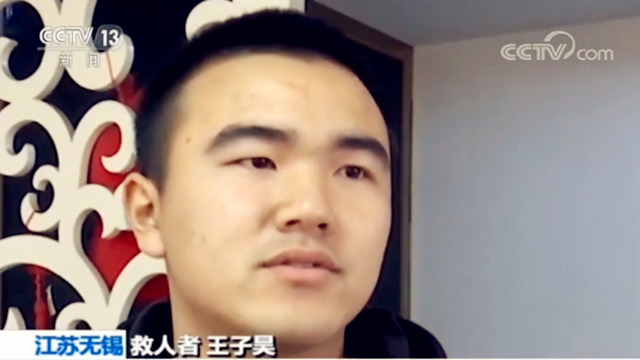
Liu Xiaoyan, the mother of the rescued child: "I want to say that this young man is really good, really good, and I have no eloquence, but I am very grateful to him and sincerely thank him."
Ding Xianman, the father of the rescued child: "I saw the video of the child turning over today, and I was very worried. It was also the first time to watch it. Later, I heard that he was a soldier. Anyway, I wanted to be a soldier since I was a child. I also admire the soldiers."

Fortunately, the good-hearted people shot in time. After inspection, the child was not seriously injured except for some bruises on his forehead.
[Safety tips] It is safe to take the escalator.
The dangerous scene I saw just now happened to children. In fact, in recent years, accidents have happened frequently on the escalator. Some people got caught in the gap of the escalator, and some accidentally fell on the escalator. How should we avoid the possible accidental injuries when taking the escalator? Let’s see what the professionals say.
Liu Wei, deputy director of the Training Department of Chongqing Public Security Fire Corps, said: "The first is the handrail of the escalator, which is easy to have a gap with this fence. If you dig this handrail groove with your hands, it is easy to clip your hands in it. The second is the gap between the ladder and the fence, which is easy to clip clothes and then people’s feet in it during exercise. The third place is this comb-toothed board. It is dangerous to touch it with your hands and feet. Please.
Liu Wei emphasized that children, especially those with strong curiosity and thin hands and feet, are more likely to be caught in the gap of the escalator and hurt than adults. Therefore, children or people who are old, weak, sick and pregnant must be accompanied by adults when taking the escalator. And if an accident happens, people around you should press the emergency stop switch of the elevator as soon as possible. The red button of this switch can generally be found at the upper and lower ends of the escalator.
Liu Wei, deputy director of the War Training Department of Chongqing Public Security Fire Brigade, said: "We should quickly press this red button, a red button on the fence here, shut down the escalator, quickly broadcast a rescue call, and notify professionals to come to the rescue."
2019 World Robotics Congress: More than 700 cutting-edge products unveiled.
On August 20th, the 2019 World Robotics Congress kicked off in Yizhuang, Beijing. More than 180 well-known enterprises from the global robotics field made amazing appearances with more than 700 cutting-edge products. It was not only an exposition where robots showed their talents and competed with each other, but also an exploration and practice of presenting researchers with "animals" (bionic robots), "people" (commercial robots) and "tools" (intelligent manufacturing equipment) as the innovation direction, so that
Big birds, jellyfish, sharks … …
Bionic robots are particularly dazzling.
Nature and science and technology seem to be two very different disciplines, but in fact they are inextricably linked. At this World Robotics Congress, "bionic robots" that imitate biology and engage in biological characteristics are particularly evident.
“3、2、1!” At the moment when the silver-white bird model suddenly flickered its wings and flew vigorously into the air, the audience gave out bursts of exclamation. I saw that it sometimes rotates and sometimes vibrates its arms. After dozens of seconds, it can fly back to the "master’s" arms accurately.
According to the relevant person in charge of festo, this intelligent flying bird was designed as a high-performance and ultra-light flying model by the R&D personnel on the basis of successfully analyzing the flight mechanism of birds. Its aerodynamic characteristics are excellent and extremely dexterous. Its wings can not only flap up and down, but also be driven to a specific angle by an active articulated torsion drive unit, and the electronic system integrated on it can accurately and efficiently control its torsion according to the wing position.
ROBK-SHARK intelligent bionic shark unmanned submersible developed by Boya Gongdao is also an industrial underwater fish robot platform. According to reports, it uses a three-joint bionic tail fin as the only power source, and is equipped with a 110 wide-angle and 16 times optical zoom starlight camera. The shell adopts membrane vibration sound absorption structure, which can realize underwater low noise work, thus greatly improving the concealment of the equipment.
Smart arms, flexible lower limbs, and brain-brain switching … …
Humanoid commercial robots are amazing.
In the development of robots, imitating human beings has always been one of the main directions. There have been many amazing achievements in the field of humanoid commercial robots.
German Agile Robots (Beijing Siling Robot) and Kinifinity jointly developed the wearable motion capture device (glove+coat), which can control the operation of the mechanical arm and dexterous hand freely and remotely, such as steadily grabbing the mineral water bottle and continuously pouring water into the glass. Li Yang, marketing department of Beijing Siling Robot, said that this kind of motion capture remote control equipment has been applied to related operations in space to some extent.
In the just-released Guoman Ne Zha, Yi Er’s equipment is mixed with Tian Ling and hot wheels, which is deeply rooted in people’s hearts. Nowadays, the best friend "Little Nezha" (U06), which is similar to Yier’s actions in the field of robotics, makes its debut, and its freely coordinated movement of lower limbs is amazing. According to Liu Xuenan, CEO of Kangli Youlan, it has the ability to intelligently adapt to various complex environments through the combination of lower limb movements with wheeled gait and efficient combination of fast and slow doubles.
Chuangchuang, an intelligent business service robot, seems to be able to "see through" children’s temper. According to the relevant person in charge of Chuangze, its biggest feature is to take the lead in completely opening the "brain" and "cerebellum" of robots to users, so that you can quickly learn professional knowledge in various industries and become an "expert".
Intelligent manufacturing, warehousing and logistics, diving equipment & HELIP; …
Tool robot catches people’s eyes
Walking into the industrial robot exhibition area, the most eye-catching thing is that a complete blue intelligent robot arc welding production line is placed in the booth of Shougang in An Chuan. According to Cao Li, deputy general manager of the company, this system can be used to assemble automobile parts intelligently, accurately and efficiently.
The L4 logistics unmanned vehicle of Jingdong Logistics can achieve high-precision positioning at the lane level, accurately identify pedestrians, traffic signs and avoid obstacles through the deep integration of laser and vision and the use of high-precision maps. There is also its self-developed Chinese pallet access system, which mainly includes ground wolf AGV, six-axis mechanical arm and vision system, unmanned stacking forklift, four-way shuttle car and three-dimensional shelves.
Harbin Institute of Technology Robot Group brought a wearable underwater power backpack developed by one of its technology companies, which is novel and unique. This underwater swimming aid, which can be switched between various sports modes, has a backpack weighing 6.8kg (including battery) and a battery life of 50 minutes. Using the power generated by the electric propeller, divers can complete some difficult movements on the surface and underwater.
(Science and Technology Daily, Beijing, August 21st, by reporter Hualing, Liu Yuanyuan and Liu Yan)
From high-tech to China tradition, tour the top ten new spas in the world.
Whether it’s a comprehensive detoxification treatment or just a good comfort and indulgence, there is never a lack of excellent spa choices in the world.
In the past year, hundreds of healthy and green spas opened around the world, which may indicate that spas have changed from pure luxury to an essential part of travel.
From the sunny Mediterranean coast of Sicily to the high-end spas in the Caribbean, CNN has selected ten new spas that they think are the best in the world based on service, treatment, facilities and environment.
This article is compiled with a few abridgements. Source: CNN

Rocco Forte Spa, Verdura Resort (Sicily, Italy)
This 43,000-square-foot spa located on the southwest coast of Sicily is different from other spas in Italy.
First of all, it has its own private coastline, and it can take a panoramic view of the Mediterranean from every angle.
Not surprisingly, seawater bath therapy is used here, using seawater and marine elements as elements of medicine and treatment.
There is a complete system of seawater bath therapy, with four outdoor swimming pools providing different degrees of salt and heat.
Such as seaweed body scrub ($130), which uses locally produced marine elements such as kelp, sea salt and microalgae to purify the body and detoxify.
In addition to sea bath therapy, there is also a sauna, a 65-foot swimming pool and a juice bar, which provides organic and antioxidant-rich juice all day.
Address:Verdura Resort | Strada Statale 115, KM 131 Contrada Verdura, 92019 Sciacca, Sicily, Italy.

The Ritz-Carlton Spa in Bali (Bali, Indonesia)
Only six months after its opening, the spa in the Ritz-Carlton in Bali has proved as impressive as the hotel.
The spa, made of rain wood and smooth marble, has an advanced spa massage pool with five different areas, which can massage different parts of the body.
There are also two massage pools, cold pools, steam and sauna rooms, and a yoga studio overlooking the Indian Ocean.
In addition to fourteen independent clinics, there are four private hot spring villas, and the SPA is also equipped with its own Balinese swimming pool and open-air lounge.
The course of treatment is a mixture of ancient Balinese techniques and modern technology, and local raw materials such as coconut, seaweed and pearls are mixed into it. It is said that these raw materials have nutritional and antioxidant effects.
Address:The Ritz-Carlton, Bali | Jalan Raya Nusa Dua Lot #3 Banjar Sawangan, Nusa Dua 80363 Indonesia

The SPA, which opened at the end of last year, is located on the sixth and seventh floors of Le Meridien Gaulle, covering an area of 11,000 square feet. It is the largest spa in the city.
There is an indoor swimming pool with hydrotherapy massage and waterfall, Turkish bath, ice room and even a salt room, which is made of sea salt imported from Himalaya (it is said to promote better breathing).
But what attracts guests is the high-tech treatment here: the use of the cutting-edge Japanese formula Skingenecell 1P, which is said to be the most advanced element that can repel skin damage and aging.
Do you want to keep a low profile afterwards?
Try the Zen bath ceremony in the hot spring ($285). Two hours of soaking in rich minerals is definitely a perfect experience.
Address:Excelsior Hotel Gallia, a Luxury Collection Hotel | 9 Piazza Duca d’Aosta, 20124 Milan Italy

Thai House, Zemi Beach House Resort and Spa (Shoal Bay, Anguilla)
This is not a spa with a thatched roof that you usually see. Located on Shoal Bay, the newly opened Thai House is an all-round health center.
Here you can find the only hamam, meditation garden, mud deck, yoga studio, spa shower, vitality pool adjusted according to guests’ body temperature, and even a juice bar.
The physiotherapy room is built in a Thai house with a history of 300 years (hence the name), with a private lounge and a view of the sea or garden.
Most of the treatment uses local herbs, flowers, soil and sea salt as materials.
Address:Zemi Beach House, Resort & Spa | Shoal Bay Village Anguilla

Baglioni SPA, Baglioni Hotel London (London, UK)
Located in the bustling area opposite Kensington Park in London, this fashionable new spa is like a hidden oasis in the downtown area, with only five physiotherapy rooms and 14 treatment sessions. It can be seen that this comfortable spa focuses on quality rather than quantity.
The treatments here are extremely luxurious, ranging from a 24-carat gold mask to promote blood circulation ($200), to a diamond facial injection to reduce pigmentation and brighten skin tone ($180), and even a rare facial treatment for men ($120), with green tea and mushroom extracts to detoxify and shrink pores.
Address:Spa at the Baglioni Hotel | 60 Hyde Park Gate, London SW7 5BB England

Spa at Bernardus Lodge (Carmel Valley, California, USA)
The view from Bernardus Lodge’s new spa is worth the ticket price.
Located in the center of Monterey wine district, the spa is surrounded by 28 acres of sunny vineyards, orchards and oak forests.
It has all the advantages of a five-star spa: a huge swimming pool, an outdoor jacuzzi, a eucalyptus steam room, a shower using Vichy mineral water, a dry steam room and an advanced 24-hour fitness center.
But what really makes this spa stand out is its concept of "from garden to treatment", picking materials from its own organic garden for treatment.
From face to pedicure, it is full of lavender, mint, rosemary and Chardonnay grapes collected from vineyards.
Guests can even soak in the Chardonnay bubble bath.
Address:Bernardus Lodge & Spa | 415 West Carmel Valley Road, Carmel Valley, CA 93924

Opened in September last year, this two-story space is more like a comprehensive health center than a hotel spa.
Two outdoor massage baths, an 80-foot-long swimming pool (almost the size of the Olympic Games), several heat treatment areas and a 1,300-square-foot gym, which is the largest spa in Ho Chi Minh City.
Like the hotel, this spa is exceptionally gorgeous, completely covered with carrara marble, hand-inlaid mosaics and gold.
The treatment is also luxurious, ranging from mother-of-pearl body scrub ($90) to top-class couples treatment including red wine body dressing and candlelight massage, with champagne and caviar snacks ($820).
Address:The Reverie Saigon | 22-36 Nguyen Hue Boulevard, District 1 57-69f Dong Khoi Street, District 1, Ho Chi Minh City, Vietnam.
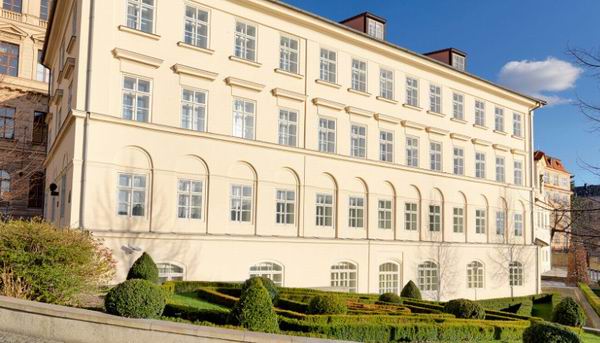
Bohemia Spa, Four Seasons Hotel Prague (Prague, Czech Republic)
The city’s newest spa boasts unparalleled views of vltava river, Charles Bridge and Prague Castle.
In addition to its location, the spa itself is also amazing. It is located in a neoclassical building with a mineral-rich hot bath and an oxygen-enhanced vitality pool that is said to have healing effect.
The course of treatment is inspired by traditional Czech and Hungarian methods, using local materials such as linden oil.
Although it won’t be officially opened until this summer, you can try the treatment at the hotel’s existing spa.
Address:Four Seasons Hotel Spa | Veleslavinova 2A, Prague

Qingchengshan Liushan Hotel Spa Center (China, Sichuan)
Located at the picturesque foot of Qingcheng Mountain, a UNESCO World Heritage Site, this brand-new spa located between hills and valleys is as quiet as the treatment provided.
There are no high-tech courses here, but acupuncture, cupping and scraping.
Body dressing and scrub use simple but effective local ingredients, such as ginkgo, lotus seeds, ginger and bamboo.
Address:Qingchengshan Liushan | No.2 Neusoft Avenue, Qingchengshan Town, Dujiangyan, China.

Thermes Marins, Hotel Hermitage Monte-Carlo (Monaco)
The Ocean Hot Spring Center, which was renovated and opened last year at a cost of millions of dollars, may be just what you expected to see in Monaco-a bird’s eye view of Monte Carlo Pier, with its own hot bathroom, salty pool facing the ocean, the leading gym in China and a full-service beauty salon.
This is also the only spa in Europe that uses cryotherapy, with two freezing rooms at MINUS 60 degrees Celsius and MINUS 110 degrees Celsius. Cryotherapy is said to stimulate the immune system, treat inflammation and resist aging.
The spa even has an organic restaurant, L’Hirondelle, which only serves seasonal dishes with less than 500 calories.
Address:Thermos marins Monte-Carlo | 2 Avenue de Monte-Carlo, Monte Carlo, Monaco
Ministry of Industry and Information Technology: Consolidate and enhance the competitive advantage and leading position of the information and communication industry, and strengthen the construction a
On July 26th, the symposium of responsible comrades of the national industrial and information technology authorities was held in Beijing.
The meeting pointed out that the Third Plenary Session of the 20th CPC Central Committee was a very important meeting held in the critical period of comprehensively promoting the construction of a strong country and the great cause of national rejuvenation with Chinese modernization. The meeting deliberated and adopted "the Central Committee of the Communist Party of China’s Decision on Further Comprehensively Deepening Reform and Promoting Chinese Modernization", which made systematic arrangements for further comprehensively deepening reform, and defined the guiding ideology, theme, general goal, major principles, major measures and fundamental guarantee for further comprehensively deepening reform. It is not only a continuation of the practice of comprehensively deepening reform since the Third Plenary Session of the 18th CPC Central Committee, but also a new chapter in the era of promoting Chinese modernization in the new journey.
Put forward the work in the second half of the year:
It is necessary to promote the high-quality development of the industry, consolidate and enhance the competitive advantage and leading position of the information and communication industry, strengthen the construction and application of new information infrastructure, deepen the regulatory reform of the information and communication industry, and strengthen the network and data security capabilities.
We should make every effort to promote the steady growth of industrial economy, continue to give play to the leading role of key industries and regions, actively expand domestic demand, focus on stabilizing the export of industrial products, and strengthen the monitoring and dispatching of industrial economic operation.
It is necessary to solidly promote the digital transformation of manufacturing industry, carry out the digital transformation of manufacturing industry and the special action of artificial intelligence to empower new industrialization, accelerate the large-scale application of industrial Internet, and build an open source system in China with high quality.
It is necessary to speed up the cultivation of new pillars and new racetracks, seize the opportunity of a new round of scientific and technological revolution and industrial transformation, and focus on intelligent networked automobiles, new materials, bio-manufacturing, hydrogen energy, humanoid robots, metauniverse, brain-computer interface, quantum information, low-altitude economy, commercial aerospace and other fields to make precise efforts to accelerate development.
How Nano-soldiers Fight Cancer —— Do you know?
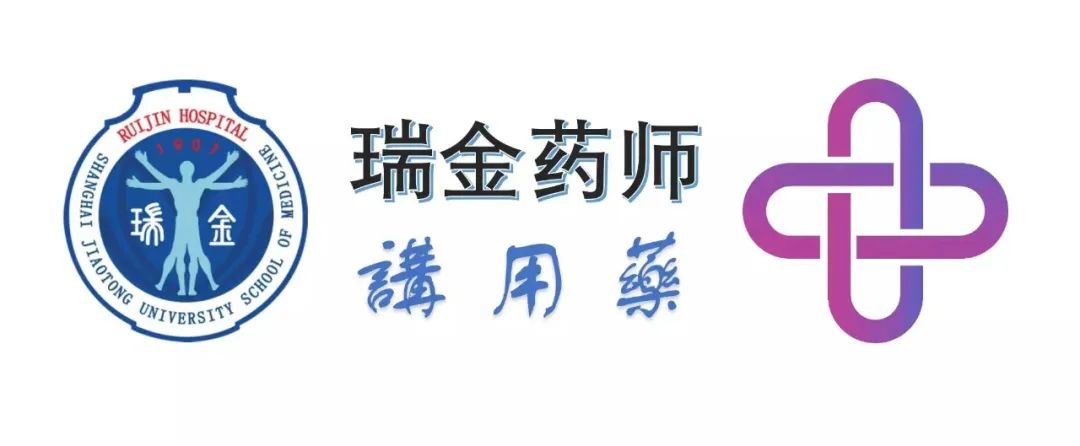
Cancer, as one of the most common diseases with high mobility and high mortality in the world, the clinical treatments for its tumors generally include surgery, chemotherapy and radiotherapy. Due to the shortcomings of chemical drugs and various toxic and side effects, people have been committed to developing more effective drug delivery systems for cancer treatment, with the aim of reducing side effects and ensuring its efficacy.
With the progress and maturity of nanotechnology, its advantages are gradually reflected.

Introduction of nano-drugs

Diagram of sustained release process of nano-drugs
Nano-drug and its delivery system
Nano-medicine refers to nanoparticles or nano-carriers, which is a new product produced by the combination of nano-technology and medicine.
Nano-drug delivery system refers to the integration of small drug molecules into nano-materials by means of encapsulation or adsorption.
Advantages of nano-drugs
First, improve the solubility and absorption of drugs.
Nano-sized drugs are different from most chemotherapy drugs. Nano-sized drugs have larger specific surface area, better solubility, faster dissolution, improved absorption properties and better therapeutic effect.
At the same time, due to better solubility, the dosage of patients can also be appropriately reduced.
Second, prolong the drug’s circulation time in vivo, and enrich it to the focus.
Through some modification and treatment on the surface of nano-drugs, the circulation time of drugs in human body can be prolonged, which is beneficial for drugs to reach the lesion site, and special modification may make drugs more concentrated in the tumor site, resulting in better selectivity and targeting properties.
Nano-drugs can enter the tumor tissue through the porous blood vessels of the tumor, and achieve a high degree of penetration and retention in the tumor. Therefore, nano-preparation has excellent properties of high drug loading rate, passive targeting and controlled drug release.

Clinical application of nano-preparation.
Paclitaxel albumin nanoparticles
Paclitaxel is a commonly used anticancer drug in clinic. Here is a brief introduction to the nano-preparation of paclitaxel:
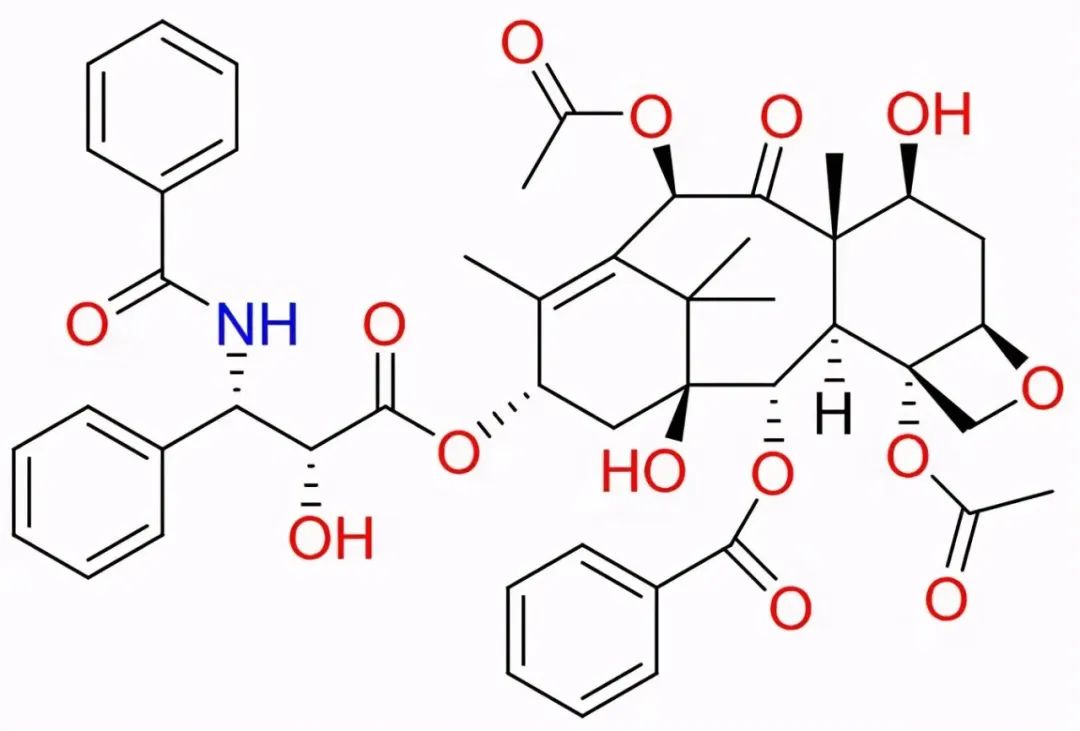
Paclitaxel, a commonly used anticancer drug
Albumin nanoparticles
Albumin nanoparticles are nano-particles based on albumin.
Albumin is an endogenous natural product with the advantages of safety, non-toxicity, non-immunogenicity, biodegradability and good biocompatibility. Moreover, the nanoparticle carrier system has unique targeting, sustained and controlled release characteristics and drug protection.
By high-pressure homogenization, paclitaxel and human serum protein preparation were made into nanometer freeze-dried powder, which can improve the solubility, avoid a large number of paclitaxel nanoparticles aggregation, and help the drug to be absorbed into tumor cells and give full play to its role.
Pharmacological action of paclitaxel
Paclitaxel is an anti-microtubule drug, which can stabilize microtubules by promoting the polymerization of tubulin dimer and inhibiting its depolymerization, thus inhibiting the normal dynamic reorganization of microtubule network during interphase and mitosis.
In addition, paclitaxel can lead to abnormal arrangement of microtubule "bundles", affect the division of tumor cells and promote tumor cell apoptosis during the whole cell cycle and cell mitosis.
indication
The application of albumin nanoparticles in the in vivo delivery of paclitaxel and cancer treatment has become a hot topic in recent years.
Albumin paclitaxel nanoparticles are mainly suitable for the treatment of metastatic breast cancer that failed in combination chemotherapy or breast cancer that recurred within 6 months after adjuvant chemotherapy.
Unless there are clinical contraindications, an anthracycline anticancer drug should be included in previous chemotherapy.
matters need attention
In the process of using paclitaxel albumin nanoparticles, it should be noted that paclitaxel for injection (albumin binding type) also has adverse drug reactions and must be used under the guidance of a doctor with chemotherapy experience.
Only with perfect diagnosis and treatment facilities can the complications and adverse reactions caused by drugs in treatment be effectively controlled.
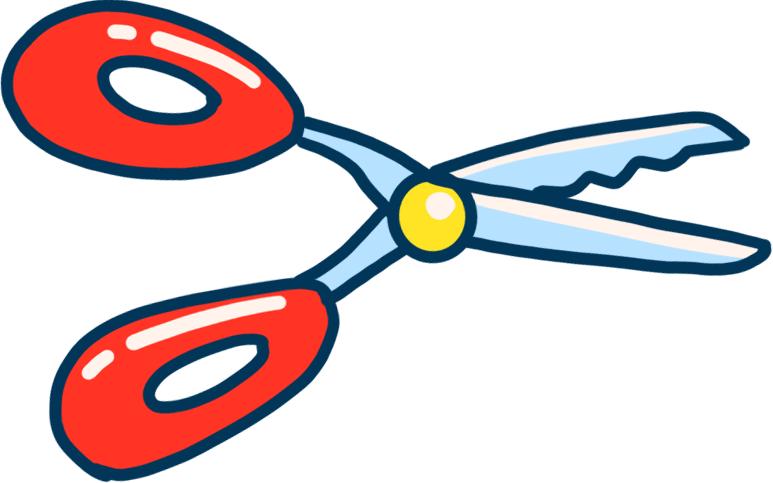
references
[1] Jie Chen, Cao Ye, Li Shuangshuang, Luo Lailong, Yu Peng, Li Mingyuan. Research progress of novel nano-drug delivery system for tumors [J]. China Journal of Pharmacy, 2020,55(21):1749-1756.
Xin li, Zhu Dandan, Chen Yu, Lin Shuting, Han Lili, Li Ying, Liu Xiaoxuan. Research progress of nano-drug delivery system in promoting deep penetration of tumor [J]. Zhongnan Pharmacy, 2020,18(12):2009-2018.
Zhao Shuang, Zhang Shaofang, Mu Xiaoyu. Research progress of nano-drugs [J]. Tianjin Pharmacy, 2020,32(02):57-61.
Chen Dongxiao, Zhang Juanmei, Li Jianye, Xu Tianhong, Dong Yaqin, Pu Xiaohui. Research status and progress of paclitaxel albumin nanoparticles [J]. Journal of Henan University (Medical Edition), 2017,36(04):296-300.
[5] Chen Kang. Analysis of the research progress of paclitaxel pharmaceutical preparations [J]. Heilongjiang Medicine, 2019,32(06):1390-1392.
Contributed by: Song Haolin (Ruijin Intern Pharmacist)
Original title: "How do nano-warriors fight cancer-do you understand? 》
Read the original text
Handling of Proposal No.20220291 of the Fifth Session of the 12th CPPCC National Committee of the Autonomous Region
Suggestions: Suggestions on vigorously improving the local matching rate of automobile parts and enhancing the overall competitiveness of automobile industry chain.
Automobile industry is an important industry in Guangxi and a pillar industry in Liuzhou. Liuzhou is one of the important automobile industry gathering places in China, with four automobile enterprises including SAIC-GM-Wuling, Dongfeng Liuqi, faw liberation Liuzhou Branch and Guangxi Automobile Group. In 2021, the estimated output value will exceed 175 billion yuan, and the automobile production and sales will reach 1.88 million and 1.89 million respectively, among which the output of new energy vehicles will exceed 480,000, up 157.6% year-on-year.
At present, the automobile industry is facing an unprecedented change in a hundred years, and the automobile industry chain in the whole region is facing great challenges:
1. The layout of the "Three Electricity" industrial chain of new energy vehicles in Guangxi is not perfect, and the supporting system and R&D capability of the whole industrial chain of vehicles have not been upgraded. There are shortcomings in supporting local intelligence, networking, domestic chip components and intelligent driving control systems. For example, in 2021, leading enterprises in Guangxi’s new energy automobile industry, such as SAIC-GM-Wuling and Dongfeng Liuqi, are facing the problem of strong market demand but shortage of core components (control chips, power batteries, engines, etc.), and the satisfaction rate of SAIC-GM-Wuling core chips is only 30%.
Second, the core industrial chain is underdeveloped, and the localization, research and development and manufacturing capabilities of core components such as high-performance engines for passenger cars, automatic transmissions, and new energy vehicles "Three Electricity" need to be improved. The intelligent manufacturing level of local supply chain is not high, and the production operation efficiency can not meet the future competition. Take SGGM-Wuling as an example, the automation rate of its supporting suppliers in Liuzhou is about 30%, which is half that of supporting suppliers in Chongqing; The completion rate of digital factory transformation is less than 10%.
4. In recent years, Liuzhou City has successfully explored the "Liuzhou Model" for the promotion and application of new energy vehicles through the linkage between government and enterprises. In 2021, the autonomous region also introduced relevant policies for the promotion of new energy, but the promotion and application of new energy passenger cars and commercial vehicles in other cities still need to be further strengthened.
5. The competition in the new energy automobile industry will be more intense. The number of new energy automobile main engine plants has reached more than 76, and the traditional automobile giants have launched brand-new new energy vehicles. At the same time, the electric replacement models and hydrogen battery models of commercial vehicles of major automobile enterprises have also appeared. It is estimated that the output of new energy vehicles will reach 5 million in 2022.
The new energy automobile industry has become the key field of the future competition of the world automobile industry. Promoting the transformation and upgrading of the automobile industry in Guangxi is particularly important for the development of Guangxi during the "Tenth Five-Year Plan" period. It is urgent to introduce more key projects, create more competitive parts products, maintain the stable operation of the industrial chain, improve the local matching rate of automobile parts and enhance the overall competitiveness of the automobile industry chain.
To this end, it is suggested that:
First, make the industry leader bigger and stronger, and improve the driving ability and efficiency. Give full play to Liuzhou’s role as a pioneer of high-quality industrial development in the whole region, and relevant departments of the autonomous region will increase policy support and land use security to promote the strong chain, supplementary chain and extension of Liuzhou’s new energy automobile industry chain. We will increase the layout of the independent controllable capacity of the automobile industry chain led by SAIC-GM-Wuling and Dongfeng Liuqi, support the accelerated development of new energy vehicle projects, and constantly improve new energy platforms, large and medium-sized logistics vehicles, HEV energy-saving vehicles, commercial vehicles, trams and hydrogen energy commercial vehicles, enhance local basic process design, research and development capabilities and manufacturing capabilities, and consolidate the foundation of the automobile and equipment manufacturing industry chain. In five to eight years, the local matching rate will gradually increase by more than 15%, the output value of new energy automobile industry will increase by 50 billion yuan, the output value of high-tech and high value-added supply chain will increase by more than 20 billion yuan, and the total automobile production and sales will increase by 5% every year, and the market share in the country will reach more than 10%, and the total output value will increase by more than 100 billion yuan.
Second, relying on the leader to promote the gathering of industrial chain elements of the new four modernizations. In combination with the 14th Five-Year Plan of Guangxi Automobile, the relevant departments of the autonomous region, aiming at the weak points of the "new four modernizations" industrial cluster, have issued targeted policies and measures for attracting investment, carried out precise investment and special investment, attracted leading enterprises in the new energy automobile industry to settle in Liuzhou, strived to introduce a number of "three power" and intelligent networked supply chains, planned chip packaging, testing and application localization projects synchronously, and gradually built a new four modernizations with complete elements.
Third, improve the level and support the digital and intelligent upgrading of the industrial chain. Strengthen the cooperation of the government, scientific research institutions, enterprises and other parties, build leading enterprises, promote the intelligent upgrading of the industrial chain, focus on cultivating core enterprises such as SEEK Technology, focus on the upgrading of intelligent workshops and smart factories, accelerate the construction of industrial Internet, deepen the cost reduction and quality improvement of the automobile industrial chain, and enhance the competitiveness of the existing local parts market; Vigorously build a public service platform for intelligent manufacturing, support enterprises to carry out technological innovation, mechanism system innovation and business model innovation, and stimulate enterprise innovation and creativity.
Fourth, strengthen the promotion of new energy vehicles and cultivate the development environment of new energy vehicles in Guangxi. Pilot application of "Liuzhou Model for Promotion and Application of New Energy Vehicles" in various cities in the whole region, and promote and apply new energy commercial vehicles, urban logistics vehicles, special vehicles and other vehicles in ports, factories and mines and long-distance trunk transportation in conjunction with Guangxi Automobile Group, Dongfeng Liuqi and Heavy Duty Truck Transportation; Promote the application of new energy sanitation vehicles in urban and rural areas; Introduce financial leasing companies and other models, start commercialization pilots, and promote the application of new energy logistics vehicles in the fields of postal services, express delivery, and e-commerce terminal logistics; Give full play to the advantages of intelligent new energy vehicles and actively promote the transformation and upgrading of new energy commercial vehicles and special vehicles to participate in the intelligent transformation of ports, factories and mines.
Five, the implementation of the policy, increase the introduction and cultivation of high-end talents such as the "new four modernizations". Support, guide and encourage OEMs to strengthen the construction of innovative teams, implement the talent strategy of "going out" and "bringing in" in parallel, and continuously consolidate the stability and development of talent teams. On the one hand, we will build talent enclaves and R&D enclaves, break geographical restrictions, and gather industry elites to contribute to industrial chain construction. On the other hand, we will further optimize the talent introduction and education policy, improve the talent development environment, improve the talent care and protection policy, and strive to build a high-end innovative talent team with key core technologies, lead the industrial development, and promote the transformation and upgrading of the industrial chain, and strive to maintain the stability of high-end and special talents in enterprises.
Organizer: sponsored by the Department of Industry and Information Technology of the Autonomous Region, assisted by the Liuzhou Municipal People’s Government, the Science and Technology Department of the Autonomous Region and the Investment Promotion Bureau of the Autonomous Region.
Handling the reply:
Liuzhou Municipal People’s Government on the 12th CPPCC Autonomous Region
Letter of opinions of the fifth meeting on proposal No.20220291
Department of Industry and Information Technology of the Autonomous Region:
Now, we will inform you of the handling of the suggestions put forward in Proposal No.20220291 of the Fifth Session of the 12th CPPCC Autonomous Region on vigorously improving the local matching rate of auto parts and enhancing the overall competitiveness of the automobile industry chain. Please reply to the proposer together after synthesis.
I. Production and Marketing of Automobile Products in Liuzhou City
In 2021, the city’s vehicle production and sales were 1.895 million and 1.882 million respectively, up by 8.2% and 4.7% year-on-year. The growth rate of production and sales was 4.8 percentage points and 0.9 percentage points higher than that of the whole country, and the sales growth rate outperformed the national market. Among them, the production and sales volume of new energy vehicles all reached 482,000, up by 157.6% and 158.7% respectively year-on-year, and the sales volume of new energy vehicles produced in Liuzhou accounted for 13.7% of the national sales volume of new energy vehicles.
II. Answers to the suggestions made in the proposal
(A) on the "bigger and stronger industry leader, improve the driving ability and efficiency" proposal.
In recent years, the autonomous region and Liuzhou City have continuously optimized the industrial development environment, improved the policy support system, enriched the service methods of enterprises, fully supported the transformation and development of the automobile industry, and made the leading enterprises bigger and stronger. Liuzhou actively supports SAIC-GM-Wuling, Dongfeng Liuqi and other automobile main engine plants to increase the research and development of new products, and supports SAIC-GM-Wuling to implement the "two million" new energy platform project and the research and development of E-series and Hongguang MINI new energy vehicles; Support Dongfeng Liuqi to develop T5EVO, yacht, S50EV, hydrogen fuel commercial vehicle and pure electric commercial vehicle; Support the research and development of G100 new energy logistics vehicle of Guangxi Automobile Group. Actively promote the construction of the national automobile quality inspection center (Guangxi) intelligent networked automobile closed test site and Liuzhou automobile networking pilot area, and support the transformation and upgrading of automobile products of automobile OEMs. At the same time, actively assist leading automobile enterprises to explore overseas markets, the new energy automobile market in Guangxi and the northern market.
Focusing on the leading enterprises in the automobile industry, we will increase the layout of independent and controllable capabilities in the automobile industry chain. The autonomous region issued the Work Plan for Promoting the Transformation, Upgrading and Development of the Automobile Industry, the Notice on Improving the Local Matching Rate of Automobile Parts, the Notice on Printing and Distributing the Work Plan for Making SAIC-GM-Wuling Leading Enterprises Form the Whole Industry Chain of Liuzhou Automobile, and the Notice on Printing and Distributing the Work Plan for Making Dongfeng-Liuzhou Leading Enterprises Form the Whole Industry Chain of Liuzhou Automobile. Liuzhou has issued such policy documents as Implementation Plan for Transformation and Upgrading of Liuzhou Automobile Industry, Several Measures for Promoting the Development of Mould Industry in Liuzhou City and Several Measures for Promoting the Development of Casting and Forging Industry in Liuzhou City, which strongly support the construction of strengthening, supplementing and extending the chain of Liuzhou automobile industry chain.
In recent years, Liuzhou’s automobile industry has overcome the adverse effects of rising raw materials, repeated epidemics, chip shortage and power shortage, and gradually realized the transformation from traditional fuel vehicles to new energy vehicles. The production and sales volume have rebounded year by year, and the automobile production and operation of the OEM have achieved good results. In 2021, SAIC-GM-Wuling produced 1.672 million vehicles, up 8% year-on-year, of which 458,000 new energy vehicles were sold, up 157.5% year-on-year. Dongfeng Liuqi produced 200,000 vehicles in 2021, up 11.2% year-on-year, including 125,000 passenger vehicles, up 35.6% year-on-year. At present, there are E100/E200/E300 new energy automobile products produced in Liuzhou.
/E300Plus/ Hongguang MINI EV, S50EV, G100 logistics vehicles, Dongfeng Liuqi new energy power exchange vehicle, Dongfeng Liuqi hydrogen fuel commercial vehicle and other new energy vehicle products, and the products are gradually serialized.
Liuzhou plans to build a well-known domestic R&D and production base for the whole industrial chain of new energy vehicles in about five years, and build a well-known domestic new energy automobile city in Guangxi, with a production and sales scale of over 2 million vehicles and an output value of over 170 billion yuan. The production technology of complete vehicles and main parts enterprises has reached the domestic leading level. In the next step, several key projects will be implemented in the new energy automobile industry: First, the "two million" new energy automobile platform project of SAIC-GM-Wuling. Invest 30 billion yuan to build two platforms of millions of new energy vehicles, pure electric vehicles and hybrid vehicles, accelerate the localized production of the industrial chain of new energy vehicles, and realize the new output value of more than 100 billion yuan. Second, Dongfeng Liuqi new energy transformation project. Invest 4.3 billion yuan, strive to sell more than 10,000 new energy vehicles such as hydrogen fuel heavy trucks, and realize the new output value of new energy heavy trucks of more than 12 billion yuan. The third is the transformation project of new energy vehicles of Guangxi Automobile Group. Invest 3 billion yuan to develop the new energy logistics vehicle market, form three major product series of passenger cars, trucks (modified vehicles) and off-road vehicles, and at the same time promote the OEM plan of new energy passenger cars, achieving an additional output value of more than 10 billion yuan. Fourth, the new energy automobile industry chain extension and chain repair project. Invested 12 billion yuan, introduced Qingshan Ruipu power battery, United Automotive Electronic New Energy Vehicle Controller, Wuhan Yuanfeng ABS Controller and other projects, with an added output value of more than 50 billion yuan.
(B) on "relying on leading enterprises to promote the new four industrial chain elements gathering" proposal.
Liuzhou insists on promoting the electrification, intelligence and networking development of the automobile industry as an important direction to promote the transformation and upgrading of the automobile industry. Relying on the continuous improvement of the new energy automobile product market of SAIC-GM-Wuling and Dongfeng Liuqi, Liuzhou has carried out accurate investment promotion and accelerated the layout of supporting industrial chains. Liuzhou Guoxuan Hi-Tech New Energy Battery 5 GWh Project, Huating Power Battery Pack Production Line and Liuzhou Shuanglin New Energy Motor Project were completed and put into operation, SAIC-GM-Wuling built the first automobile controller production line, Sykes hybrid engine was developed, Penghui new energy storage project and Sykes Ruipu new energy battery project started construction, and the United Electronics Phase III new energy electric control drive project and Nexter new energy parts project were signed. Taking the construction of the car networking pilot area as an opportunity, we will increase investment attraction and introduce 8 industrial projects related to intelligent networking. The industrial chain construction of new energy vehicles has achieved good results, and various major core components have been put into production one after another. At present, local production of major components such as new energy power batteries, drive motors, bridges and controllers has been realized.
In the next step, in accordance with the relevant requirements of investment promotion of key industrial chains in the autonomous region and Liuzhou, we will continue to further promote the project of supplementing and strengthening the chain, especially for the upstream of new energy vehicles and intelligent network connection, and gradually build a new four-oriented industrial chain with complete elements.
(C) Suggestions on "upgrading the level and supporting the digital and intelligent upgrading of the industrial chain"
Liuzhou steadily promotes the construction of key industry platforms, with automobiles and construction machinery as the main line, and government and enterprises work together to support leading enterprises in the industry to build industry-level industrial Internet platforms and promote the digital transformation of upstream and downstream enterprises in the industrial chain. SAIC-GM-Wuling digital supply chain collaborative intelligent industrial Internet platform has been included in the pilot demonstration project of the Ministry of Industry and Information Technology for three consecutive years, and has been popularized and applied in more than 700 parts enterprises. More than 900 enterprises have carried out procurement collaboration on Guangxi machinery industry Internet platform built by Liugong. The Cheheyun Industrial Internet Platform built by Guangxi Automobile Group has been applied by more than 700 suppliers.
(D) Suggestions on "Strengthening the promotion of new energy vehicles and cultivating the development environment of new energy vehicles in Guangxi"
Liuzhou actively supports the local automobile main engine factory to carry out the promotion and application of new energy vehicles, and has formed the "Liuzhou model" for the promotion and application of new energy vehicles. In 2019, Liuzhou City and 13 other cities in Guangxi jointly launched the "Guangxi New Energy Vehicle Promotion and Exchange Series" to jointly explore and practice the "Guangxi Model" for the promotion and application of new energy vehicles, cultivate and expand the new energy vehicle market in Guangxi, and achieved remarkable results. By the end of March 2022, the total output of various new energy vehicles was 935,000 and the total sales volume was 916,500; The number of new energy vehicles is 122,700, accounting for 12.31%; Built 1016 charging pile sites and 11378 charging piles (2032 fast charging piles and 9346 slow charging piles); 530 public charging socket stations, 7041 public sockets and 17357 personal sockets have been built.
In the next step, Liuzhou will continue to accelerate the development of the new energy automobile industry, encourage SAIC-GM-Wuling and Dongfeng Liuqi to speed up the development and listing of new energy products, realize the increase in sales of new vehicles as soon as possible, and at the same time seize the favorable opportunity of the national new energy vehicles going to the countryside, accelerate the construction of charging infrastructure in counties and townships under the jurisdiction of Liuzhou, create a favorable environment for the promotion of new energy vehicles in counties and townships, and promote the extension of the promotion and application of new energy vehicles to counties and townships. At the same time, actively strive for the support of the autonomous region, increase the promotion and application of the "Liuzhou model" in the whole region, and create a good environment for the promotion and application of new energy vehicles produced in Liuzhou.
(V) Suggestions on "implementing policies and increasing the introduction and cultivation of high-end talents such as the" new four modernizations "
Liuzhou has issued some policy documents, such as "Several Measures for Accelerating the Gathering of Talents in the New Era in Liuzhou" and "Detailed Rules for the Classification of Talents and the Implementation of Incentive Subsidies in Liuzhou (Trial)", to increase the introduction of talents. From October 1, 2018, the city will achieve the goal of total talents exceeding 1 million in five years, including 100 high-end talents, 3,000 senior management talents, 3,000 doctors and masters, and high-skilled talents. According to different levels of talents, preferential treatment is given from salary, living allowance, housing purchase (rental) allowance, children’s enrollment and other aspects.
In 2022, Guangxi New Energy Automobile Laboratory settled in Liuzhou. Through joint innovation of politics and Industry-University-Research, it focused on five major sectors, namely, technical research, product development, intelligent manufacturing, industrial chain and ecological construction, and built the highest level and level of scientific and technological R&D innovation platform in Guangxi, creating a whole-chain R&D innovation base, a new highland for industrial talents training and a source of industrial ecological model in the whole region, and accelerating the "double-chain" integration of industrial chain in innovation chain. At the same time, in the process of layout of science and technology projects, guide local car companies to carry out joint research with universities, research institutes, key laboratories and other units, set up talent cultivation indicators, strengthen the construction of talent teams, and enhance the R&D and innovation capabilities of enterprises. In the introduction of high-level talents, we should pay more attention to the accurate introduction of talents, pay attention to the introduction of high-end innovative and entrepreneurial talents, achieve a benign interaction between talents and industries, and achieve a win-win situation for the development of talents and industries and enterprises. At present, four high-level talent projects in the automobile industry have been introduced to Liuzhou, including two B-type talent projects, one D-type talent project and one E-type talent project.
I am writing this letter.
the peopl citye’s government of liuzhou
June 24, 2022